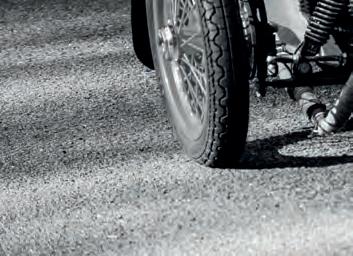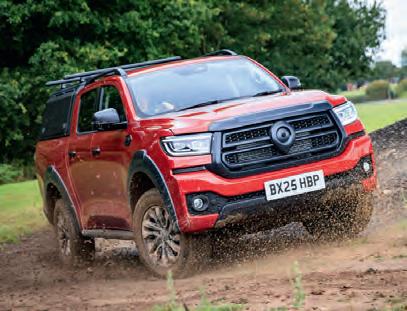
DRIVEN GWM POER300: First test of China’s high-spec, high-value double-cab



DRIVEN GWM POER300: First test of China’s high-spec, high-value double-cab







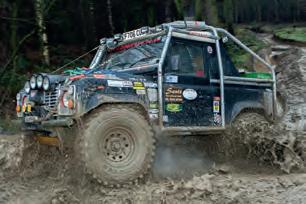
GREEN MACHINE
Gnarly 90 saving the planet one mud pit at a time
In the mud, on the lanes and around the world – including proof of what you can achieve with good old leaf springs…





Overlanding in the vehicle they call the money pit WALES MEET AGAIN
POSH WAY ROUND


Delivering mud terrain performance with all-terrain manners
CF9000 RUGGED TERRAIN
• Anidealfitmentforworking and leisure conditions
•Sidewall design enhances the extra climbing ability
•Pattern design reduces road noise


•Optimised tread design increases wear and puncture resistance



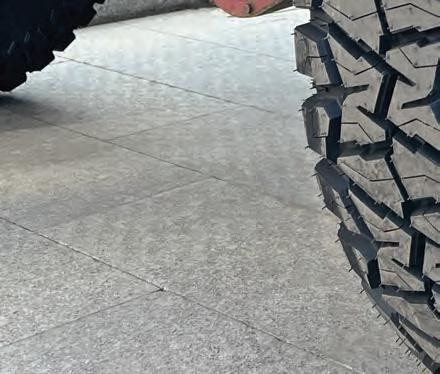







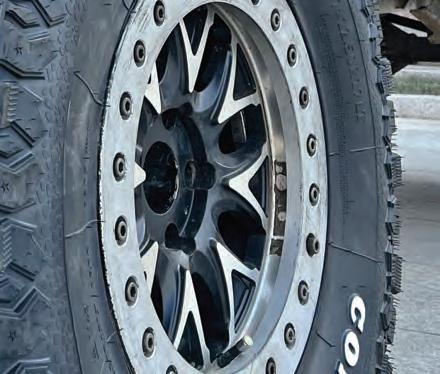
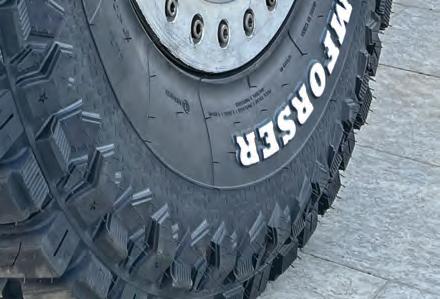
TF975 Roof Rack
TF1707 2.5m Hard Case LED Awning
TF1731 LED Shower Awning
TF705 Spot Lights
TF1038 Raised Air Intake
TF7220 Bulk Head Light Brackets
TF7116 Lights
TF31038 Halo & Bar Indicator & Side Light
TF7112 Halo & Bar LED Headlights
TF31011 Dynamic Side Repeaters
TF270 Grille & Headlight Surround
TF0028 TRED Winch Bumper
TF3360 12,500lb Twin Motor Winch with 50m Synthetic Rope
TF0017 Steering Guard
TF844 Front Diff Guard
TF662
TF667
TF488 2.5” Competition 8 Stage 12” Travel Remote Reservoir Shock Absorber
TF545 Mounting Kit
TF542 / TF544 / TF140 Bump Stops
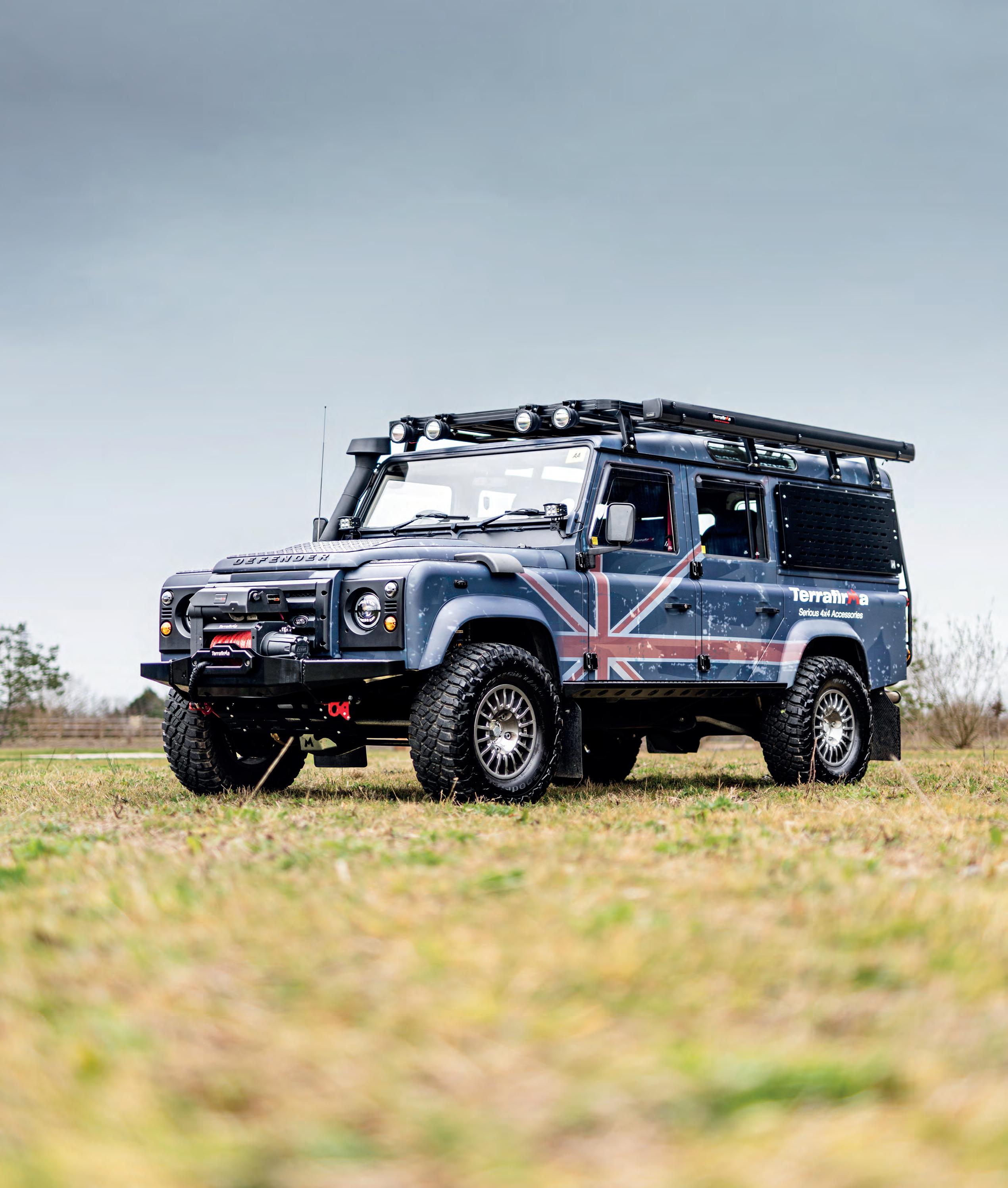
Wind Deflectors
Wind Deflectors
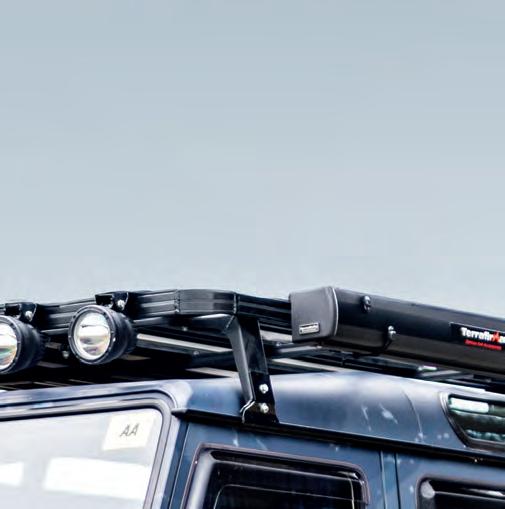
TF979 Flip Up Window
TF979BIN Internal Storage Bin
TF978 Fold Down Shelf
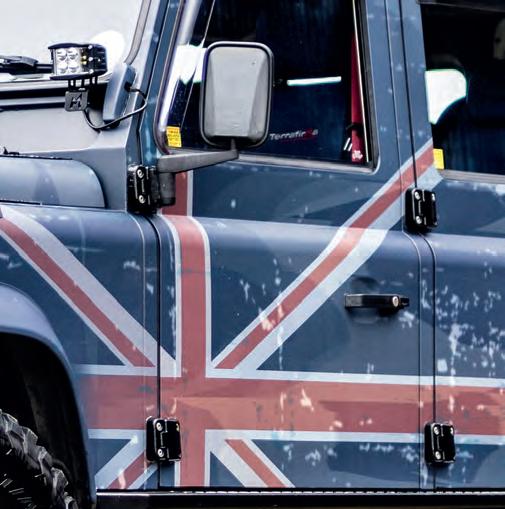
TF301 30mm Wheel Spacers
TF161G Winrace Aluminium Wheels


TF051 Swingaway Spare Wheel Carrier
TF980 Rear Ladder

TF686 Big Brake Upgrade Front / Rear
TF645GD Stainless Steel +2” Braided Hose Kit

TF3010B Front Mudflap Brackets
TF3012B Rear Mudflap Brackets

range of Terrafirma Defender parts designed to enhance your journey.



www.terrafirma4x4.com

Tel: 01283 742969
Email: enquiries@assignment-media.co.uk
Web: www.totaloffroad.co.uk www.4x4i.com
Online Shop: www.toronline.co.uk
Facebook: www.facebook.com/totaloffroad www.facebook.com/4x4Mag
Editor Alan Kidd
Design Ian Denby-Jones
Contributors
Mike Trott, Gary Martin, Olly Sack, Gary Noskill, Dan Fenn, Paul Looe, Tom Alderney, Jan and Noam Ben Tsion
Photographers
Steve Taylor, Richard Hair, Vic Peel, Harry Hamm
Advertising Sales
Colin Ashworth
Tel: 01283 742969 isabelle@tandemmedia.co.uk
Subscriptions Agency
WW Magazines, 151 Station Street, Burton on Trent, DE14 1BG Tel: 01283 742970
Publisher and Head of Marketing
Sarah Moss
Email: sarah.moss@assignment-media.co.uk
To subscribe to 4x4, or renew a subscription, call 01283 742970. Prices for 12 issues: UK £42 (24 issues £76); Europe Airmail/ROW Surface £54; ROW Airmail £78
Distributed by Marketforce; www.marketforce.co.uk
Every effort is made to ensure the contents of 4x4 are accurate, but Assignment Media accepts no responsibility for errors or omissions nor the consequences of actions made as a result of these. When responding to any advert in 4x4, you should make appropriate enquiries before sending money or entering into a contract. The publishers take reasonable care to ensure advertisers’ probity, but will not be liable for loss or damage incurred from responding to adverts
Where a photo credit includes the note ‘CC BY 2.0’ or similar, the image is made available under that Creative Commons licence: details at www.creativecommons.org
Overlander 4x4 is published by Assignment Media Ltd, PO Box 8632, Burton on Trent DE14 9PR © Assignment Media Ltd, 2025


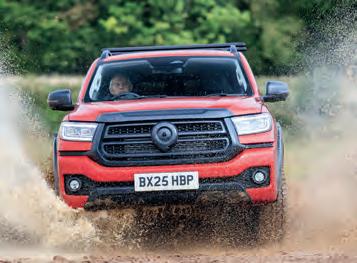


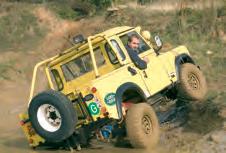








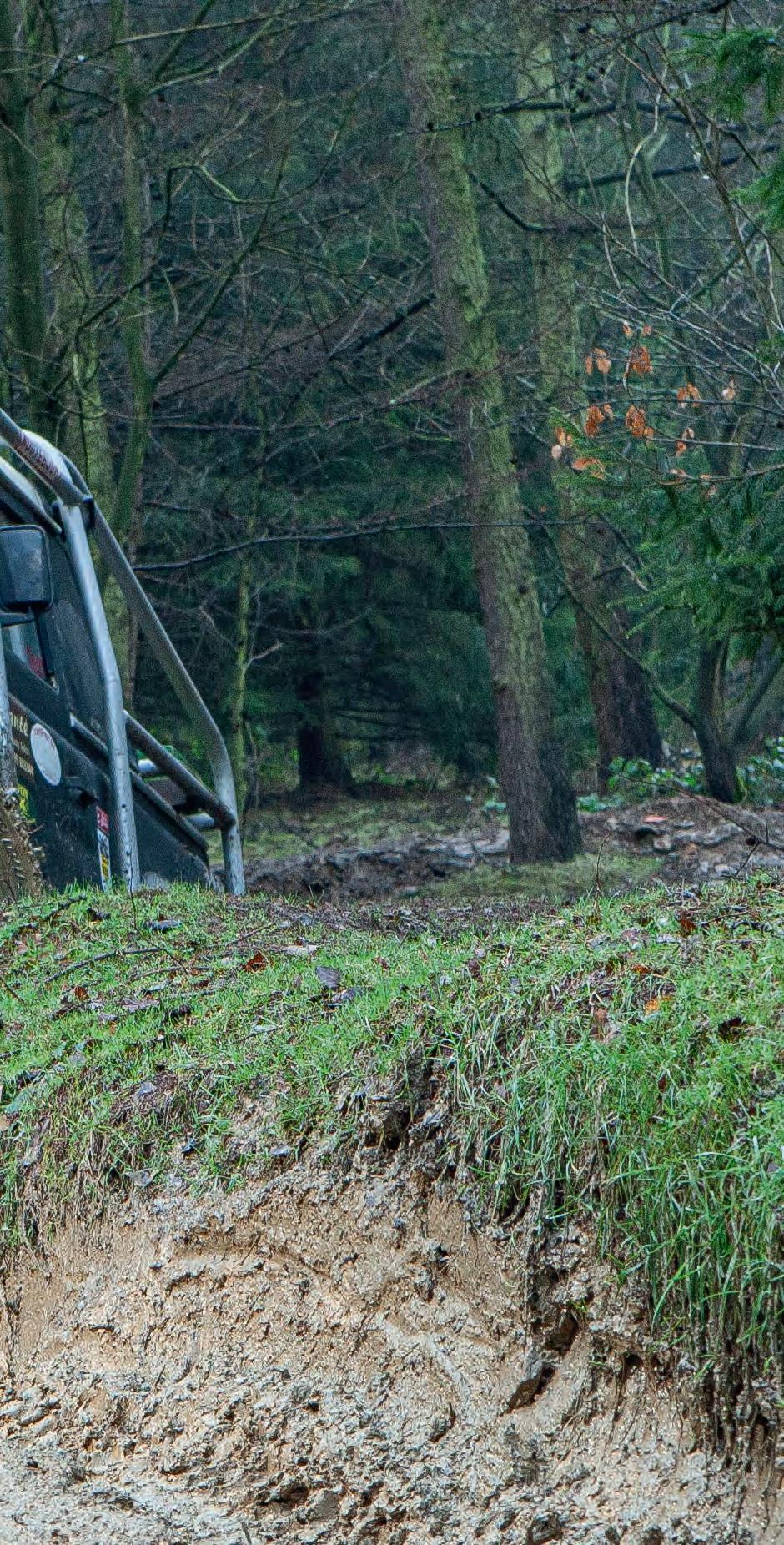
Pay quarterly by direct debit and you can get Britain’s only all-marques 4x4 magazine delivered to your door – for less than half the price on the front cover!
4 News
Suzuki plays the value card with the new e Vitara and Land Rover Classic unveils a Works Defender named after Winston Churchill
10 Rights of Way
Joined-up thinking on voluntary restraint
12 Products
ARB’s best ever air compressors, and switches for those well known classics, the Disco 2 and Td5 90
52 Subscribe
Get Overlander 4x4 delivered for a fraction of the cover price
64 Next Month
Get set for a modified Volkswagen Amarok done for Vee-Dub cred rather than pure off-road smarts
16 GWM Poer300
First drive of the Chinese double-cab that gives you more kit for your cash than you thought possible
20 Restified Disco 2
What’s that we were saying about the Discovery 2 being a classic now? If Legacy Overland have taken to reworking them, maybe they are after all
24 Playing with Gas
You don’t see many original V8 90s running on LPG – or being used as playday toys…
32 Leaves on the Line
People are restoring them like mad, but a leafer can still be a heroic off-road warrior – and there’s much that you can do to modify them
38 Throne of Games
Bit of a king, bit of a barbarian… the fearsome Khal Drogo lends his name to a 110 built to take the rough with the smooth
42 You’ve Been Framed

A Tdi 90 emerges from the AL Services workshop with a new chassis and a new lease of life
40 Wet in Wales
A green lane trip that started out damp, ended up sunny and stayed gloriously mountainous the whole way through
54 Disco 3 Around the World
People call it the Money Pit, but Land Rover’s first truly high-tech off-roader was capable of doing the same things as its old-school trucks
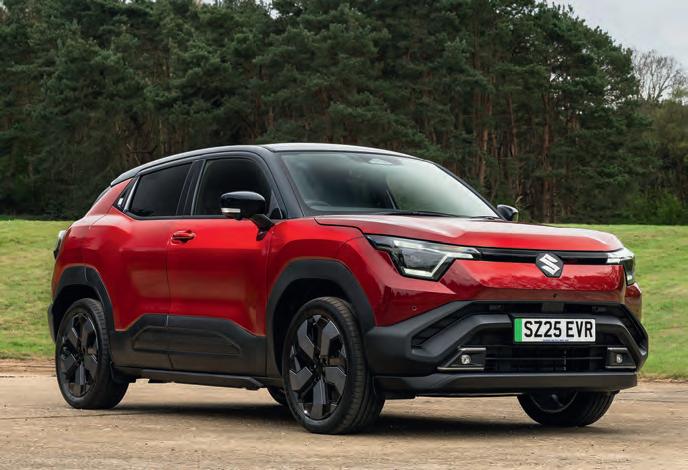
WITH THE E VITARA ON THE WAY, Suzuki has introduced a package of launch offers which will run to the end of the year. Called Suzuki Granted, this is a response to the Government’s recently announced Electric Car Grant, which the company is passing on in full to its customers.
In addition, customers buying an e Vitara before the end of December will receive an Ohme home charger which is included as part of their package.
The e Vitara range includes Motion and Ultra trims, 49kWh and 61kWh batteries and the choice of two or four-wheel drive. Headline figures include a range of up to 264 miles and an APR of 2.9% for PCP sales. Prices with the Granted scheme applied now start a £26,249, with 4x4 models costing from £31,249 to £34,049.
POPULAR WORDS THAT BEGIN WITH C include chav, clown, criminal, cash and carbon. If you have enough of one, the Range Rover Sport now comes with more of another than ever to help ensure that absolutely nobody, oh no, not a soul, never, mistakes you for any of the rest.
The Range Rover Sport SV Carbon introduces ‘exclusive ultra-lightweight detailing’ to the vehicle. These include a Forged Carbon exterior detailing pack and an optional Twill Exposed Carbon bonnet. There are four extra paint options in addition to the existing SV Premium range and a standard 23” alloy wheel fitment with black anodised calipers.
Not special enough? Carbon fibre wheels are also available, as are carbon ceramic brakes and a choice of blue, yellow, bronze and black calipers.
Inside, you can have leather seats in Ebony, Rosewood/Ebony or Light Cloud/ Ebony – or leather-free Ultrafabrics in Cinder Grey/Ebony. There’s more forged carbon on the seat backs and dash, as well as extended dark chrome around the cabin and illuminated badging on the kick plates.
As you expect at the top of the Range Rover Sport family, power comes from the 4.4-litre twin-turbo V8 petrol engine whose 635bhp, 553lbf.ft makes it sound fantastic and shift like mad, in that order for most people. And on the subject of sounding fantastic, inside the cabin you get Body and Soul Seat (BASS) technology to let you feel the sound of the music playing on the audio system rather than just hearing it.
‘The new Range Rover Sport SV Carbon is an assertive interpretation of our luxury performance SUV,’ says marketing man


Ryan Miller. ‘Offered alongside Range Rover Sport SV and SV Black, it completes the new line-up showcasing the best of Range Rover’s sophisticated carbon fibre materials, for the ultimate expression of lightweight performance.’
What this means in terms of cash is £165,045 (three clicks on the options list and we had this upstairs of £190).
So that’s one of the big C’s taken care of; others can be expected to come naturally.
KGM is the latest manufacturer to unveil its electric pick-up plans, with the future Musso EV shown to the public for the first time at a Supbikerun triathlon event in the Lake District in September. Despite still being in development, the electric doublecab was available for test drives – which, KGM says, ‘will help inform the vehicle’s potential development journey.’ Specifications are still some way from being finalised, however the current intention is to offer it with all-wheel drive and a drivetrain package allowing a range of up to 290 miles. That would be unladen; payload and towing capacities are not mentioned, however KGM expects to equip the truck with vehicle-to-load functionality, allowing it to be used to power equipment on-site.
> Smart Anthracite finish

> Fits all Defender including early 90/110/130
> Offers a deep dish, wider offset
> Significantly improves turning circle at the same time as enhancing on road handling.
> ET0 off set, meaning no need for the use of spacers, they sit in the widest position
> PCD - 5 x 165.1
> 1,100kg load rating
DA3521
16” x 8” Caradoc alloy
DA3522
18” x 9” Caradoc alloy
DA3523
Centre cap for DA3521 & DA3522
DA3830
Set of 5 wheel nuts

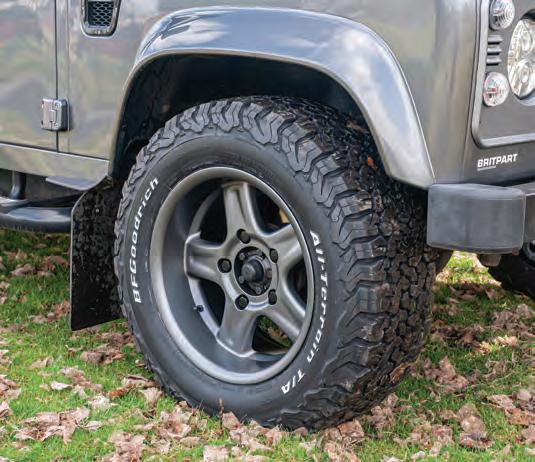



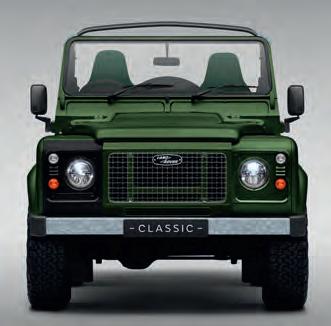
On 30 November 1954, Land Rover presented Sir Winston Churchill with an 80th birthday present to remember – a new 86” Series I. Registered UKE 80, the vehicle remained in the former Prime Minister’s family following his death in 1965, finally being sold on by his son in 1973, and today it resides in the Emil Frey Classics Museum at Safenwil, Switzerland, alongside a number of other Land Rovers and Range Rovers.
Recently, the museum was visited by a team of experts from Land Rover Classic. Sounds like a pretty good work trip – but they weren’t just there on a jolly. Their goal was to analyse the Series I’s paint, take samples of its interior trim (we do hope they asked first) and examine every aspect of its period details.
Why? Because the latest limited-edition Works Bespoke commission from Land Rover Classic is the Churchill Edition – a run of just 10 vehicles inspired by the great man’s original. The idea came from






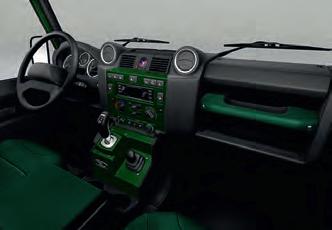
Emil Frey itself – a classic car specialist which, in addition to its museum, is an approved Land Rover Classic retailer.
The Churchill Edition features Bronze Green bodywork which, rather than just being painted off the shelf, was matched to the original following the team’s Swiss mission. The same colour is also used on the Defender’s 16” steel wheels, as well as on interior details within the cabin.
Elsewhere inside the vehicle, the seats are trimmed in Bridge of Weir semi-aniline Bottle Green leather. This also features on the passenger’s-side grab handle – an authentic touch, as Churchill’s 86 (which was primarily chauffeur-driven) also had leather here. The cubby lid is trimmed in green too, while there’s a black leather
headliner and a unique dashboard clock featuring a blue face with red stripe –inspired, Land Rover says, by Pol Roger’s Sir Winston Churchill champagne. Not something that was also seen on the original Series I, this time.
Moving back to the exterior, the front of the vehicle features a galvanised bumper, classic metal mesh grille and one matt black headlight surround. Yes, one – it’s a reference to the position of the number plate on Churchill’s Landy. Talking of the number plate, there’s a ‘UKE 80’ decal on the front wings in the now-familiar ‘HUE’ style, as well as bespoke rear badging and galvanised body cappings.
As normal with Works Bespoke Defender, the base vehicles date from 20122016. They’re rebuilt in the Land Rover Classic factory and fitted with a 405bhp, 380lbf.ft, 5.0-litre
V8 engine paired to an 8-speed automatic gearbox. Each of the 10 Churchill Editions will be built to order; clients can choose from 90 and 110 Station Wagon formats, or a 90 Soft-Top.
While Churchill was given his Land Rover as a gift from the company, this is one area in which the Defenders weren’t inspired by the original. Prices start at £232,500 for a 90 Station Wagon, £242,500 for a 90 Soft Top and £246,000 for a 110 Station Wagon – and that’s before you add VAT. You don’t have to be a Harroweducated aristocratic hereditary millionaire who grew up in Blenheim Palace to own one. But it might definitely help.




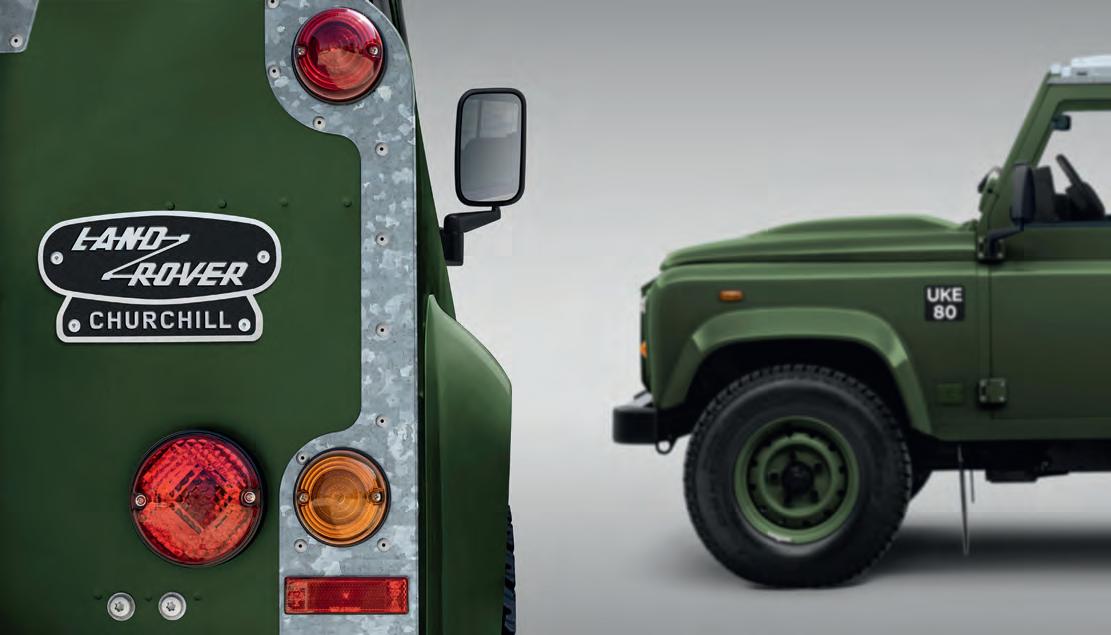

IT’S BEEN A QUARTER OF A CENTURY SINCE TWISTED AUTOMOTIVE STARTED DOING THINGS TO LAND ROVERS.
The company has gone from chipping and accessorising TD5s to fully remanufacturing as-new Pumas with Chevy LS crate engines and so on, in the process becoming perhaps THE gold-standard outfit in the poshed-up Defender game.
Poshing up Defenders is no longer just a matter of chucking a load of power and bling at the problem, however. An increasing number of specialists have started to play the EV card and thanks to a tie-up with Evice Technologies, Twisted has set out on the road towards joining them.
Evice is an EV specialist which has developed a turn-key package capable of being adapted for a variety of applications. Its first client was Halcyon, which remasters no less a vehicle than the Rolls-Royce Corniche; its new agreement with Twisted will see it supply a bespoke EV architecture solution comprising ‘state-ofthe-art electrification hardware and software, supported by its world-class battery and drivetrain expertise.’
Codenamed Project Overland, the partnership will first yield a Twisted Defender prototype with an Evice system installed as a feasibility study. This will be used for testing and benchmarking throughout the rest of this year, as well as appearing at top-end car shows as the companies promote the new venture.
Even this early in the process, however, the two companies are already looking beyond Project Overland. Evice is already talking openly about using the modular nature of its technology to develop an all-electric Range Rover Classic – again with Twisted providing the Solihull know-how.
‘The Twisted team are obsessed with perfecting the Land Rover driving experience,’ says Evice boss Matthew Pearson. ‘This aligns perfectly with our belief that electrification must build upon and complement the original character of the car.
‘This new partnership with Twisted demonstrates the adaptability of our technology and highlights the global appetite for passion-driven, properly engineered EVs born in Britain.’



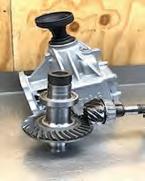

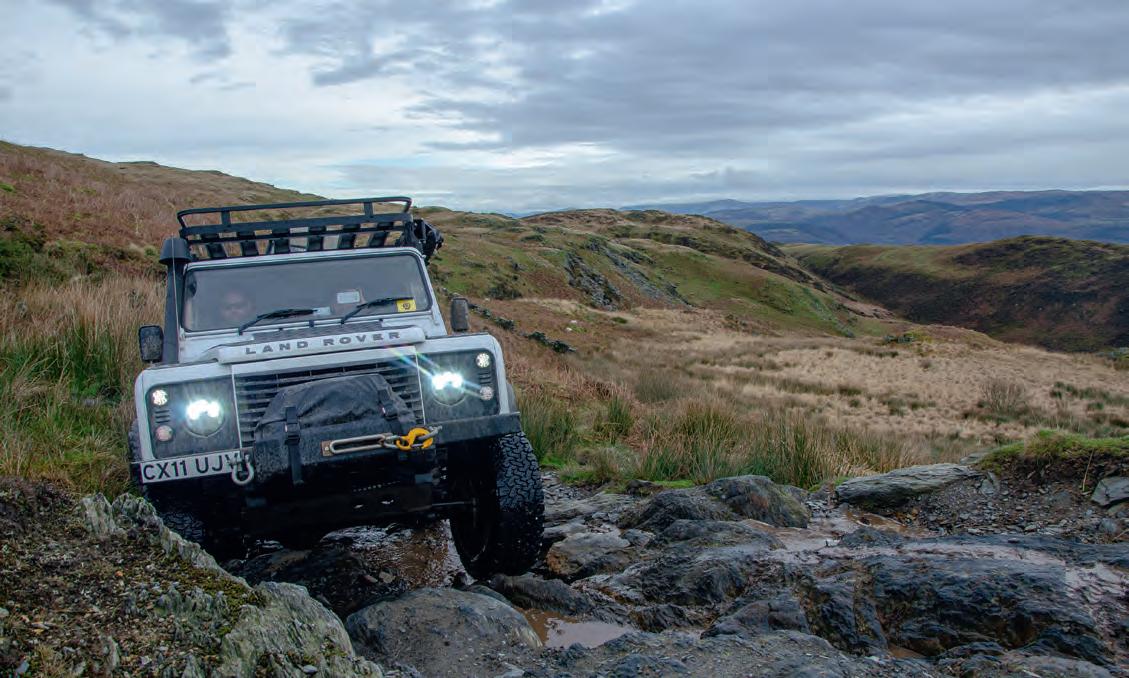
Revised VRs on popular lanes in Wales and Cumbria ensure everyone is pulling in the same direction
GREEN LANE USERS come from far and wide to enjoy Happy Valley, a byway just east of Tywyn in Gwynedd which combines glorious scenery with several bits of tricky terrain. It only reopened last year after a lengthy spell on the sidelines while the local authority organised repairs to a section that had become dangerously impassable – and even now, it remains under one-way voluntary restraint (VR).
This is in place as lengthy sections of the lane are only wide enough for one vehicle – meaning drivers would have to leave the established track to let others pass if they met head-on. This would be a serious issue amid the protected landscape of Snowdonia National Park, especially as the ground bordering the right of way can be very soft in places.
The VR notice asks all traffic to use the lane from west to east only. This corresponds to another notice on the nearby Bastard Lane, which is requested to be driven in the same direction; the two trails make a very popular combination, going together with the scenic Carn March Arthur, just to the south, to make up an iconic route.
The notice itself, however, in the shape of the recently replaced signs at the east end of Happy Valley, have been causing confusion as they suggested that the lane was not to be used at all. This has recently been dealt with by Paolo Bavaresco, Gwynedd rep for the Green Lane Association, which produced replacement signs whose message is much clearer.
As always, a GLASS rep’s job takes many forms – the prime one being to present a friendly face to a world that’s all too often suspicious of green lane users. ‘The new owner of the property at the east end chatted to me for quite a while and we exchanged details,’ reports Paolo. ‘I asked if everyone driving the route was courteous to him and he said yes – but added that they deliberately ignore the signs, often after reading them.
‘His main complaint is seemingly everyone choosing to use the hedges in front of the house as a toilet.’
A reminder there that you are always an ambassador for the 4x4 fraternity when you’re out and about on the lanes. And that you never know when you’re being watched – whatever you’re getting up to!
• Another VR notice in the news applies to The Fox, an unsurfaced road east of Grizedale in the Lake District. This has long been the subject of conflicting opinions as to which way it should be run; the national park authority has since 1995 had an agreement with the Hierarchy of Trail Routes that it should be entered from the east, however the Green Lane Association has always asked for it to be driven in the other direction.
When driving the route from the west, it starts with a long, rocky climb – where Grizedale’s role as a mountain bike centre means there’s a high risk of meeting cyclists, possibly with more confidence than skill, coming down the hill towards you at high speed and under limited control. This has long been cited by local lane tour outfit Kankku as its reason for using the lane against GLASS’ preferred direction.
Finally, however, all users will be singing from the same hymn sheet. GLASS has confirmed that its preferred direction of travel for the route is now from east to west, passing the eponymous statue of a fox on your right before dropping down the hill to finish in Grizedale village itself.








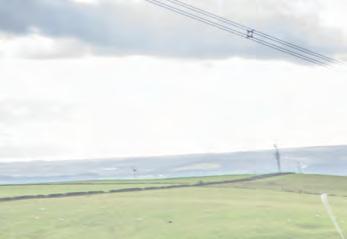
































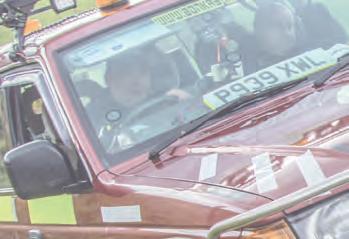
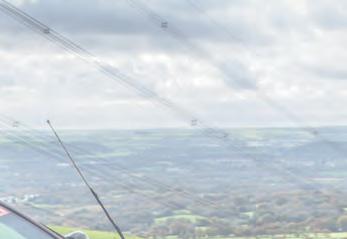




























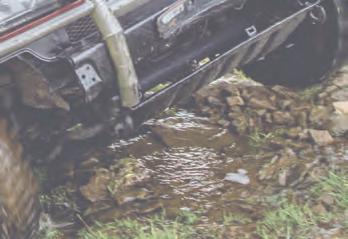


ca £675 plua VAT | www.britpart.com
There’s more to ARB than just AirLockers, but the Aussie off-road giant is still synonymous with what most people see as the gold standard in locking diffs. Which of course means air compressors have become a big part of its business.
The latest addition to the company’s range is its Brushless Twin On-board Air Compressor, and we’d challenge you to find a product of any kind anywhere with a more descriptive name than that. ARB meanwhile would challenge you to find an air compressor that gives you more for your money, as its brushless motor makes for a 50% increase in output compared to the company’s previous leading units.
Brushless motors rev higher and experience less wear than the traditional equivalent, allowing them to operate more efficiently. In addition, ARB’s compressor features active cooling, electronic speed control, constant performance monitoring and voltage and overload protection. Live diagnostics provide real-time audio and visual alerts and a staggered power-on feature helps protect the vehicle’s electrics against inrush current.
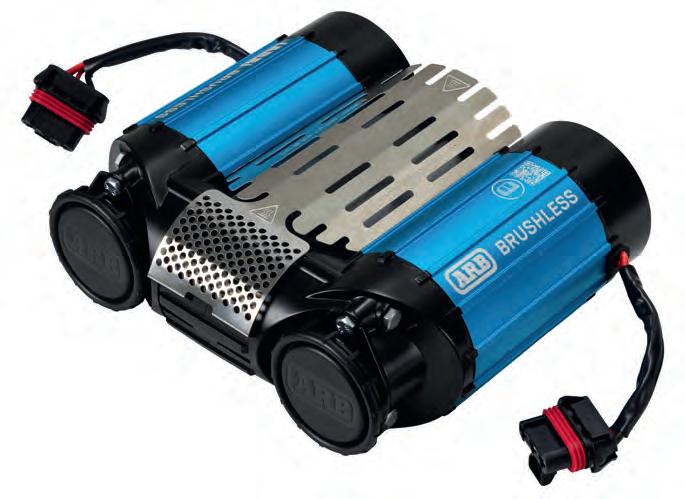
The unit also boasts various features designed for easy installation, including quick-release mounts, relay-free design and what ARB says is a foolproof polarity correction harness.
All this might sound like overkill when all you’re doing is activating a diff lock. But for high-capacity jobs like airing your tyres
Price: varies | www.britpart.com
THE DISCOVERY 2 IS A CLASSIC NOW.
So too is the Defender in Td5 and even Puma form. We know because Lucas Classic is doing bits for them.
The bits in question here are switches, operating things like the hazards, heated rear window and rear washer and wiper on Defenders all the way up to the end

of production in 2016. The heated seat switch, meanwhile, is suitable for the Defender and also the Disco 2.
Two decades have passed since the latter vehicle went out of production, which is one definition of a classic. And it’ll soon be a decade since the last original Defender came down the line, which is another (albeit a bit of an optimistic one). Safe to say that with things like chassis, axles and transfer levers, though, either is a whole lot more classic than anything that’s borne the name since. Even if they did have heated seats.
back up after a demanding off-road session it sounds like a bit of a game changer. To quote ARB’s own words, ‘whether you’re tackling rough terrain or inflating camp gear, these compressors deliver faster air, optimal efficiency, and rock-solid reliability so you can spend less time inflating and more time adventuring.’
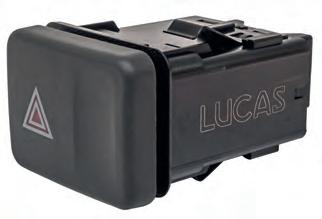

£3882-£4595 | www.millteksport.com
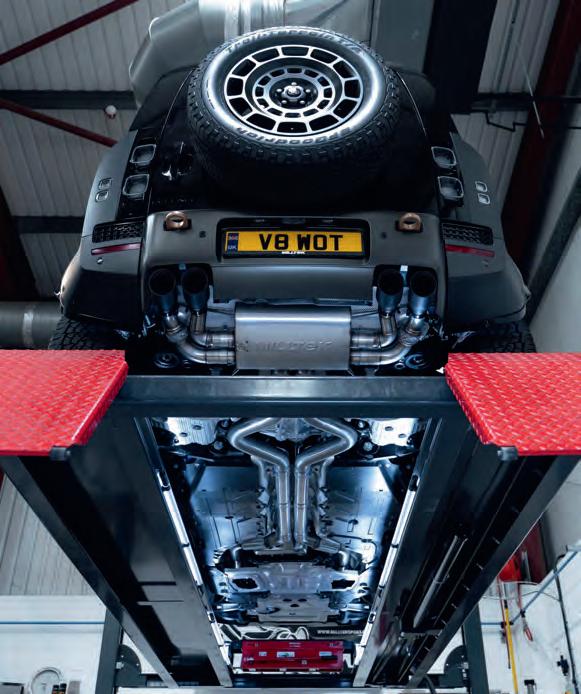
EXHAUST SPECIALIST MILLTEK has started production of a new sports system for the Land Rover Defender Octa. This is designed to ‘give it the sound it deserves’ – no, not the owner quietly sobbing while waiting for a recovery vehicle, or the police, but ‘an enhanced, deeper sound’ for its 635bhp twin-turbo V8.
Milltek notes that newer vehicles, especially those with turbos, can be disappointingly muted. They’re certainly not wrong there. So the company pulled out the stops to get its hands on an Octa as soon as possible after the vehicle’s release and started work immediately – the upshot being a non-resonated, particulate filter-back system which enhances the engine’s sound without releasing any further emissions.
The new exhaust integrates with the original valve control system, too. This means it mimics the original for performance when Octa mode is selected – only this time with the sort of note you want to hear from a big V8 on song.
Made from T304L grade stainless steel, giving it extra durability and longevity, the Milltek system has twin valves which are 80mm larger than the originals, as well as a rear silencer with a reflective design but no centre resonator. It can be specified with the company’s GT100 exhaust tips in polished black, brushed titanium and burnt titanium finishes, or left original if subtlety is your thing. Which it’s bound to be if you buy an Octa, obviously.




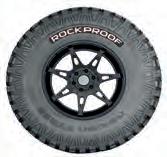

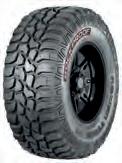























Grooved rib design delivers extra traction



3D block stepped edges improve mud and stone dispersal

Heat dissipation design minimises sudden heat changes to prevent compound deteriation



Tread’s 3D blocks and pattern rigidity increase durability

Aggressive armoured sidewall for strong traction and enhanced strength















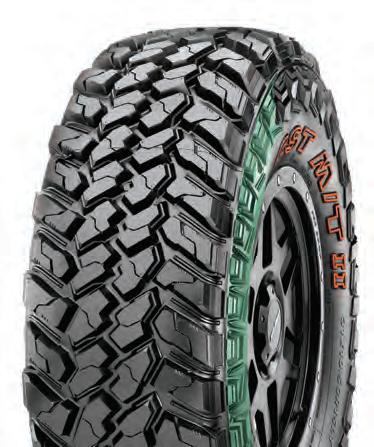





3D block design, inspired by a ram’s hoof, increases strength and durability and enhances the ability to expel mud and debris














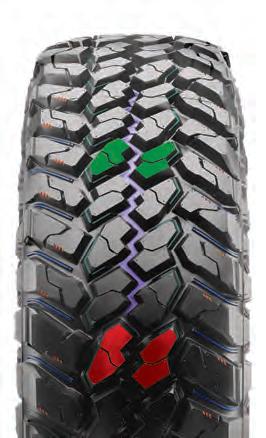
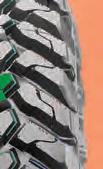




























































3D block pattern inspired by amoeba structures delivers superb performance in all terrains






Square tire profile design provides a flat contact area with high load capacity











Special pattern designed with jagged edges for extra traction to maximise off-road performance
Tread pattern’s void ratio is reduced to optimise tire mileage and tread life





Unique orange outline sidewall lettering adds eye-catching colour to your vehicle
Ribs along the aggressive shoulder provide sidewall protection and puncture resistance























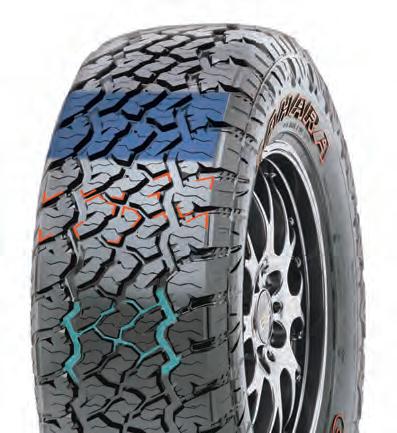





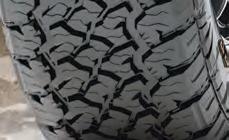





























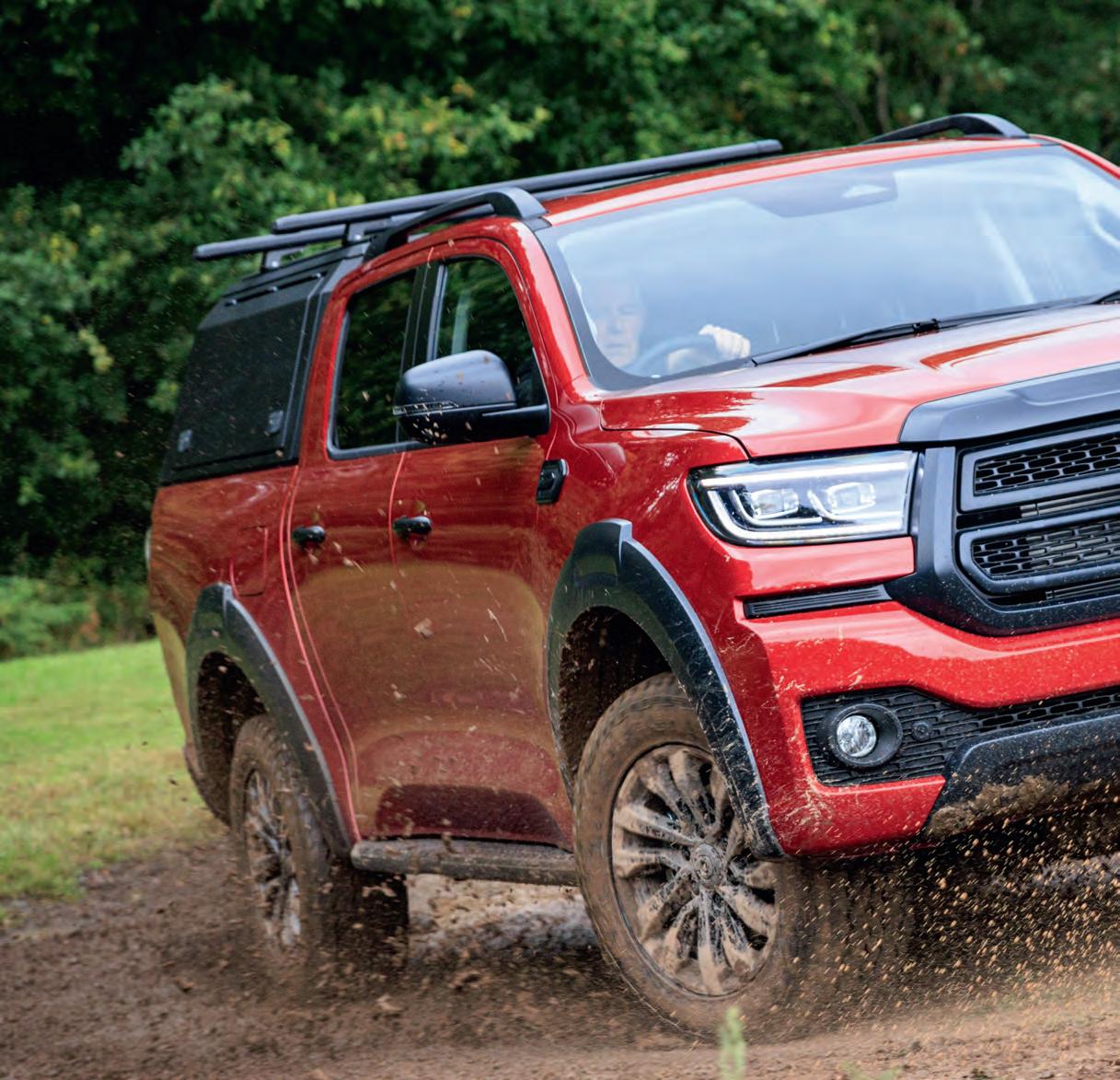

We had a Chinese pick-up truck once before. It arrived about a dozen years ago or something like that; it was called the Great Wall Steed and, well, of the four on the Trader at the time of writing the most expensive was a very low miler from 2017 and the guy was after five and a half for it. Now it’s time for another attempt. The Poer300 is also from China and it’s also from Great Wall, or GWM as they now want to be known. They company is also responsible for an electric car called the Funky Cat, so Poer300 (it’s pronounced

‘power’) is at least not the worst name out there. It’s better than Steed, too.
And that’s not the only area in which it improves on the sad old effort from back then. This time, it feels like it was made with European punters in mind. In fact, this time it feels like it was made with people who don’t want their truck’s cabin to fall apart in their hands in mind, which has got to be a good thing.
To begin at the beginning, the Poer300 is a double-cab available solely with a 2.4-litre turbo-diesel engine and 9-speed auto box. It has 183bhp and 354lbf.ft at 1500rpm,
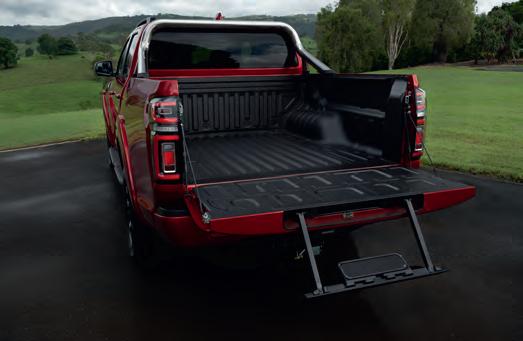
This is one of those ‘why hasn’t anyone thought of that before’ moments. Ultra and Vanta models have a fold-out step built into their tailgate, allowing you to access the pick-up bed with ease when it’s down
a 12.3” touchscreen media system with wireless phone pairing. The Lux has faux leather seats, but you’re straight up to the real thing with the Ultra.
This model also adds a heated steering wheel, power-adjustable heated and vented front seats, ambient lighting, privacy glass, a sunroof, front parking sensors and a surround-view camera, as well as a very clever step built in to the tailgate for easy access to the pick-up bed. Every other manufacturer will be looking at that and wondering why they didn’t think of it.
That’s not bad at all for an extra £3335. The price walk up to the top-spec Vanta is lower at £2000, but here all you get is styling. The actual equipment on this model is the same as on the Ultra, but its wheels, side steps, mirrors, door handles, grille, badge, arches and sports bar are black.
Your ride, your rules, but we’d stick with the mid-range model.
it’ll carry 1050kg and tow 3500kg (with a GTW of 6200kg) and the man says you’ll get 32.6mpg out of it.
Actually, we didn’t start at the beginning there, did we? It costs from £31,495 plus VAT, which gets you the entry-level Lux model. There are three trim levels in the range; the others are Ultra and Vanta, which cost £34,830 and £36,830 respectively. What this means in terms of toys will be one of the big things that pulls people in. All models get LED headlamps, park assist, reversing sensors, voice recognition, wireless charging, a 7” digital dash and
What we’ve not mentioned is safety equipment, but there’s a hefty slew of all the usual stuff and it’s standard on all models. Some manufacturers basically hold your kids to ransom as a way of blackmailing you into spending more money on extra speakers, softer leather and God knows what other gewgaws you don’t want, so good on GWM for taking a single-status approach to what you and yours are worth. There’s also a button on the steering wheel that takes you straight to the STFU menu, allowing you to quell the non-stop barrage of beeps and bongs
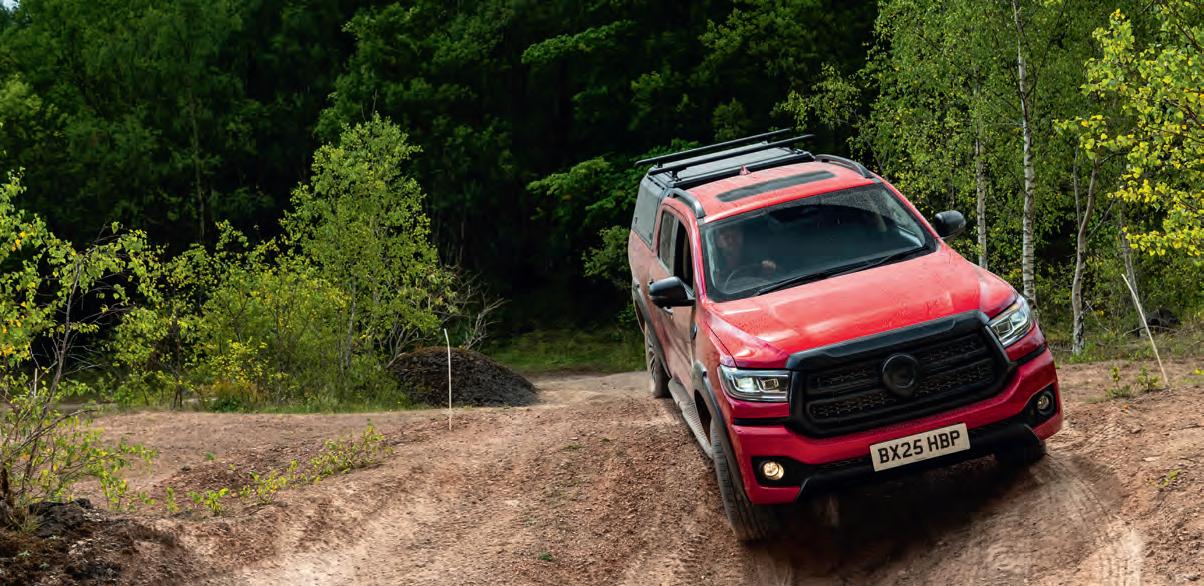
that’s been forced on the industry by recent EU diktats with a tolerable minimum of distraction and inconvenience.
We spent most of our time on the vehicle’s launch aboard an Ultra model. First impressions? If it was the work of any of the established pick-up manufacturers, you’d nod your head and say yeah, that’s okay. Maybe not Ford and Volkswagen now the new Ranger and Amarok have kicked it up in the poshness stakes, but even next to those heavy hitters the Poer300 doesn’t look silly.
It doesn’t feel flimsy, either. Chinese industry is very good at making things which
look amazing when they’re new but turn out to be horribly low quality after a bit of use, however there’s nothing to suggest GWM has taken that approach here. It feels stout, with good touch points, positive controls and little in the way of creaks and groans from the fixtures and fittings. The gear shifter looks like a toy and feels plasticky, but that’s very much the exception.
You’re sat in a good, comfortable seat with a commanding position and plenty of adjustment. There’s ample space in all directions and a tall driver will be able to stretch their legs without mashing those of

the person behind. One six-footer can sit behind another without concern – though those in the back will be hunched, as headroom here is not so generous. Bearing in mind our tester had a sunroof and the work-spec Lux does not, this is less likely to be an issue in the models most likely to be used for carrying a crew of big lads from site to site.
While we’re on the subject of the seats, adjustable lumbar support seems like a bit of a miss considering everything else they’ve thought of. We didn’t start getting achey or uncomfortable during our test

The cabin looks good, with quite SUV-like styling and no shortage at all of equipment. That’s only half the battle, though – we can’t fully tell how it’s going to wear but with good perceived quality in the materials along with a pleasing lack of groans and creaks from the fixtures and fittings, if nothing else it feels like it ought to last. There’s plenty of space up front, with lots of adjustability in the seats, and even with them pushed all the way back you can still fit a strapping six-footer in the seat behind. His knees won’t be mashed, however, but with limited headroom in the rear, a long journey might leave him with a stiff neck
drive, though it wasn’t really long enough for that to have any worthwhile meaning.
We did do a decent bit of off-roading, on a muddy and grassy course that had just been freshly soaked by a friendly early autumn downpour. The vehicles on the launch were wearing all-terrain tyres, rather than the road rubber you’ll see on final production models, but even with this advantage taken into account we were impressed by the vehicle’s natural traction. It has low range as standard, along with a locking rear diff; we used the former, as you’d expect, but managed to make it round the entire track while keeping the latter in reserve.
On the road, the diesel engine’s torque output gives it plenty of grunt. It’s not fast as such but it moves smartly enough (the quoted 0-60 time is 11.0 seconds) and you feel as if a tonne of pea shingle in the bed would do little to slow it down. It might do something to calm what is rather a fussy ride, however – though most of the fidgeting seemed to be coming from the front, so we wouldn’t count on it.
We were taken aback by its steering to start with, too, which was all weight and no feel. Playing with the drive mode settings helped here; there are three steering assist
settings, with Sport appearing to back it off to the point where it actually feels natural. Up to then, turning-in was like stirring cold treacle and trying to place the front in corners was a wrestling match as it seemingly fought to follow the while lines on the road. We tend not to criticise the sort of things you get used to as time goes on, but we mention this lest you find yourself rejecting the vehicle 100 yards into your own test drive. It is worth persevering.
That said, our experience was limited to B-roads at best and we never got anywhere near the top of the gearbox. The top three ratios are all overdrives, which bodes well for a civilised time on the motorway, and truth to tell it didn’t come over as being noticeably unrefined under acceleration either, though it doesn’t have the same degree of polish, for example, the Ford Ranger. Obviously it doesn’t have the same degree of pricing, either; the KGM Musso and Isuzu D-Max are its most obvious targets and while it didn’t do anything to rewrite the rules in those vehicles’ part of the market, nor did it suggest to us that it doesn’t belong there itself.
Of course, the D-Max has carved out a very solid place for itself by being a good truck at a good price with great backup and outstanding reliability, thus ticking all

the boxes for its core audience. It’s not an audience that tends to ‘fancy a change’ the way most SUV drivers do every now and again, either, which means the Poer300 is going to have a job to do to muscle its way in there.
Nonetheless, those prices and that kit list mean people won’t be able to help but at least take a look when they’re choosing a new double-cab. It looks and feels about as SUV-like as anything else on the pick-up market – and if it can match its value-formoney credentials with genuine longevity and dependability, we can certainly see it gaining a foothold the way the Steed never did. It has China’s reputation for making low-quality goods to get over, along with a name to make you blush – but if the Funky Cat can get people to buy it, so can this. Its job now is to reward those who do for taking a chance and braving the unknown.

Project Resolute is the latest remanufactured off-roader from Legacy Overland. The US company normally specialises in much older donor vehicles – but then, few things age as fast as a Land Rover Discovery 2…
Words Gary Martin Pictures Legacy Overland

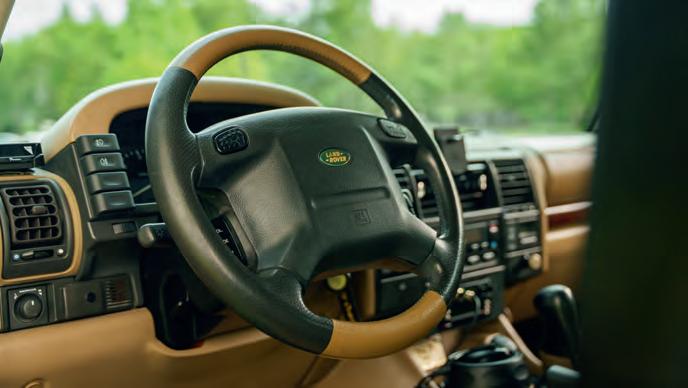
We look at vehicles built by Legacy Overland quite frequently in these pages. The company is best known for taking old Range Rovers, G-Wagens and Land Cruisers in various states of old age and remanufacturing them as newly restified fantasy wagons whose breadth and depth of engineering excellence is matched
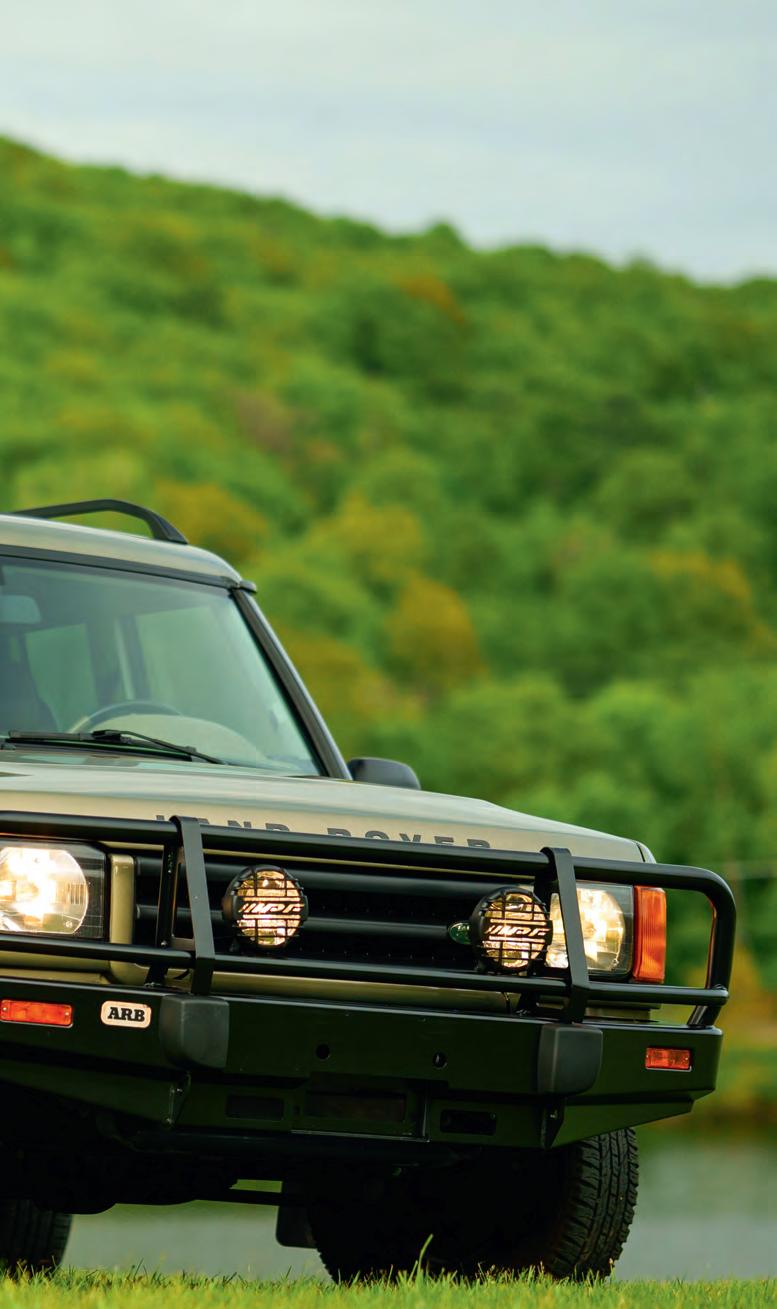
only by the imagination with which they’re specced and finished. It’s a company that makes top-end trucks and has a clientele to match.
So we were a little taken aback when they told us that their latest build. Project Resolute is not yet a quarter of a century old – a spring chicken by the company’s usual standards. However if you know your
Discovery 2s, you’ll know that they were capable of getting into a state where they needed restoring after about five years, let alone 25.
This 2001 example was, in Legacy Overland’s own words, ‘worn but willing – a veteran of daily miles and off-road trails, ready for its second wind.’ Which is precisely what they set out to give it.
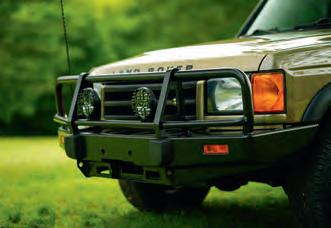

Seeing the might of an ARB winch bumper does seem a little peculiar on a vehicle shod with dinky little 255/65R16s. But it suggests to us that there’s more to come from the Disco – as does the fact that the bumper was made for a winch but is yet to receive one. It does already support a pair of IPF driving lights, though, as well as a CB aerial

‘We stripped it back and started from the bones,’ they continue, detailing what sounds like a proper tale of Disco 2 woe. ‘Diagnosed every creak, drained every bad circuit and chased the ghost of a battery drain. We overhauled the suspension with new shocks and coils, refreshed the transmission and replaced everything that had aged out –gaskets, pumps, leads, bulbs, seals.’
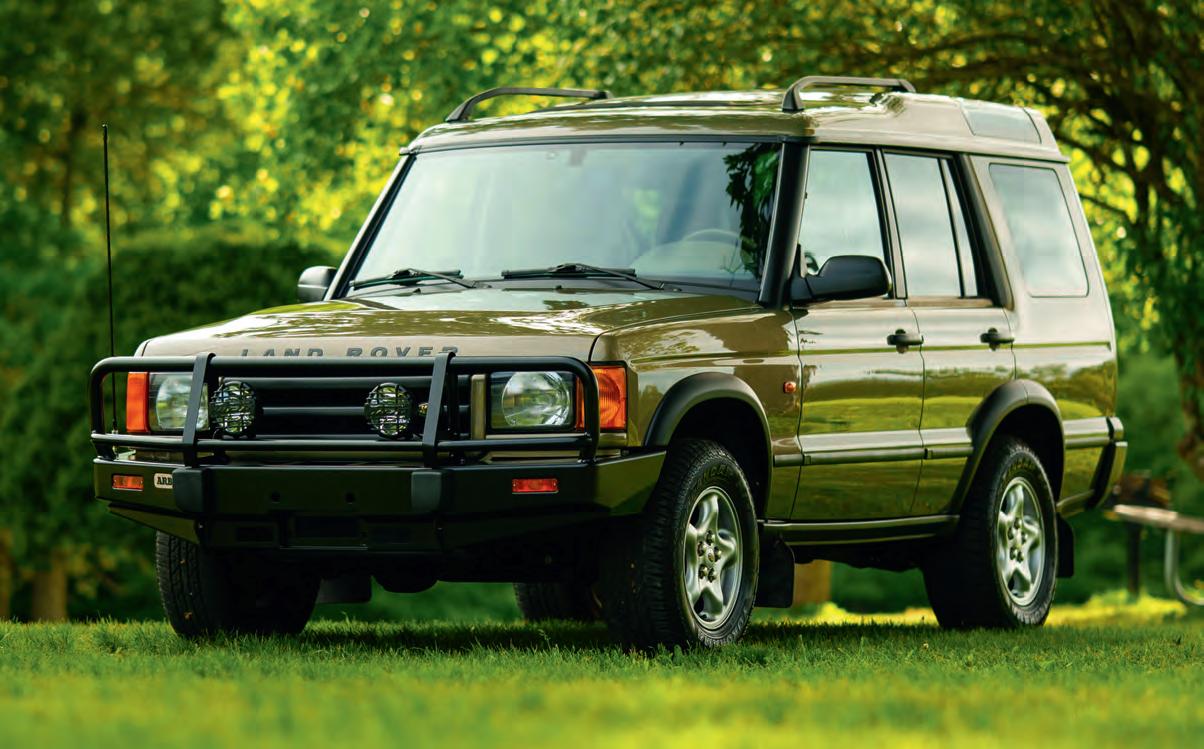
This sounds like what some specialists know as ‘baselining’ – taking a vehicle back to a position where its age isn’t going to be a constant thorn in the side of whoever drives it. Common faults are addressed and weak points shored up. But that alone doesn’t make a swan out of an ugly duckling.
This, then, is where the team from Legacy Overland swung into action with the skills they’re normally bringing to bear on those G-Wagens and classic Cruisers. ‘A full body repaint gave the Disco a high-gloss
finish worthy of the badge it wears,’ they explain. ‘The windshield was swapped and sealed. The trim was reset.
‘It stood straighter, stronger – like it had something to prove again.’
Talking of straight and strong things, it won’t have escaped your notice that the front bumper is not the one Land Rover put on it. It’s an ARB unit, no less, and they don’t come much stronger than that, especially when it’s also got a tubular bull bar growing out the top of it.

There’s a winch tray in there, too. No actual winch on it when Legacy Overland’s photos were taken, but we’ll work on the assumption that this is because the new owner was busy mulling over which brand to go for. The bumper was already home to a pair of IPF driving lights by this time, though, as well as an aerial for the CB.
Inside, the seats were reupholstered and the carpets renewed. Seat heater kits were installed for colder mornings and the sunroof and rear door seals replaced

It’s not unusual to look under the bonnet of a Legacy Overland build and find six-plus litres of LS goodness. This one’s keeping it original, though, which with this being a 2001 model means the 4.0-litre version of Land Rover’s Thor V8. (America got the 4.6 later in the Disco 2’s model life, though of course we’re not allowed nice things here in Britain so we were stuck with the little ‘un.) The engine has been given a thorough clean, and a number of bits and bobs have been renewed, but it’s still as you were in there
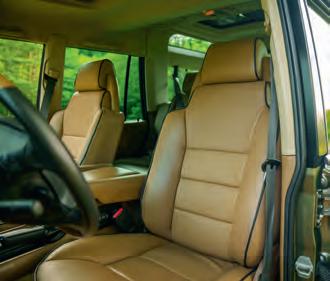
to keep the weather out. The gear shifter boots were renewed and gentle LED lighting installed behind the dash. Every bulb in the vehicle was changed, from the biggest to the smallest.
‘We gave it a new soul,’ continue the Legacy team. ‘And because modern needs call for modern tools, we 3D printed custom dash bezels, housing a CB radio and digital readouts without disturbing the factory feel.
‘It’s still a Discovery – just sharper, tighter and more capable than it’s been in years.’
For a vehicle that was ‘ready for its second wind,’ the leather in the Disco’s cabin is in phenomenal shape

You could argue that the Discovery 2 never was sharp or tight, though even if it’s not as capable as the Discovery 1 it was still a Land Rover worthy of the name. Now, with the Legacy Overland treatment, is certainly is worthy – and capable of remaining so well into the future.
Will is last as long as those Range Rovers the company specialises in bringing back from the brink? That would be some going, considering the amount of electronics involved. But it’s been in good
Right: Disco 2 sunroof klaxon. Rest easy, it’s had its seals replaced – and more importantly, Legacy Overland are not the sort to punt one out without going through it to check that a decade of rain hasn’t been getting channeled down the A-posts to the bulkhead

hands, this one – whatever the future might hold, it’s ready to face it with the true grit of a true Land Rover. Resolute by name: resolute by nature.





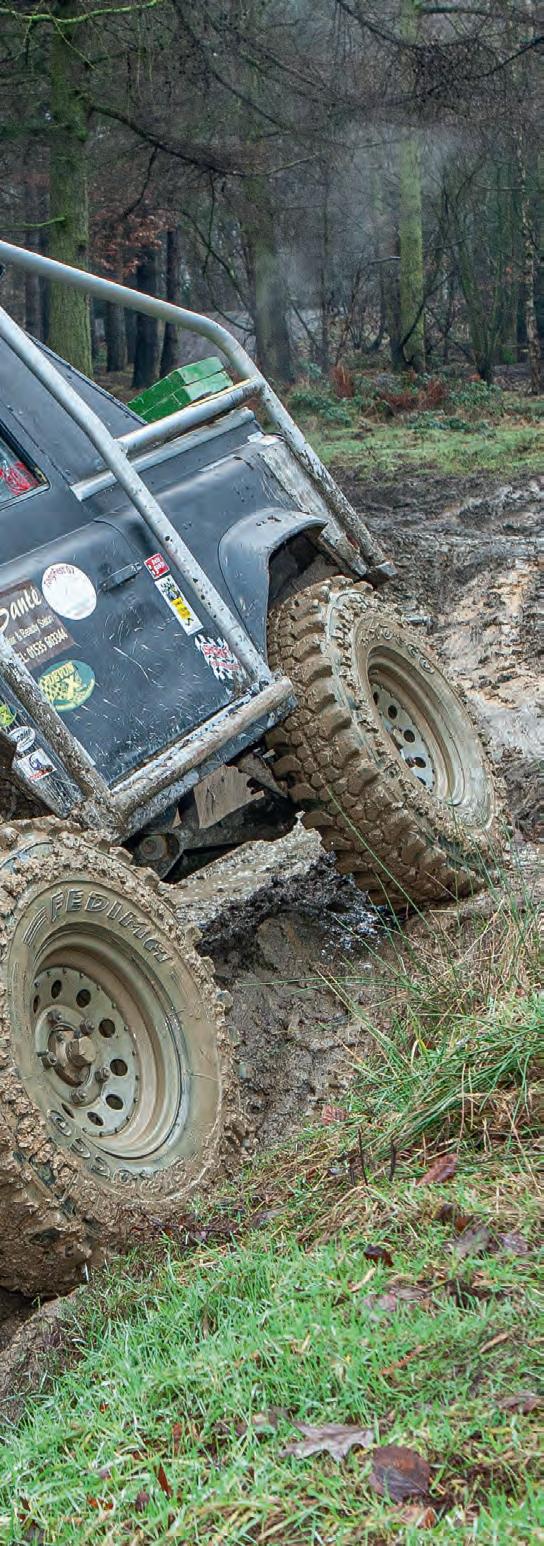
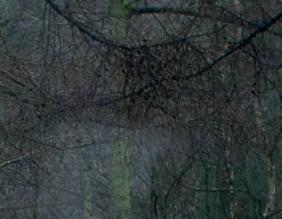
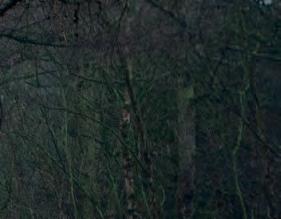

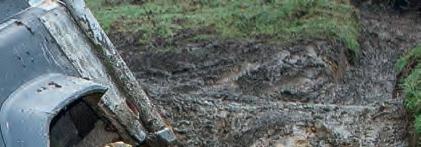



When Brian Crabtree bought a comprehensively rolled 90 as an insurance write-off, he thought it would be an easy job to rebuild it for the road. But the 90 had other ideas…



Words Tom Alderney Pictures Steve Taylor









There was a time when there were plenty of V8-engined Land Rover 90s and 110s in the world. People were forever using them as a way of making their painfully slow old motors sound nice and go well. The advent of affordable second-hand Tdi lumps did a number on that but while people have long since-stopped using the Rover V8 for repower, those that survive still retain that same aura of specialness about them.


An LS unit out of a crate is all very well, but you’ll never make a Corvette out of a Defender – and you’ll never make a Rover V8 out of anything else, regardless of how much power it’s got.





There are Rover V8s, though, and there are Rover V8s. One instinctively knows when a thing is right, as the advert for some sort of posh drink used to say, and that’s very much the case with Defenders. There are some very nice repowers around – but an original is a cut above.

Even today, if you find a V8 90 or 110 it’s likely that the engine first saw service under the bonnet of a long-since deceased SD1 or Range Rover and the vehicle started life as a 2.25 (if it’s proper old) or some sort of 2.5. The old nat-asp diesel was a favourite for hooking out back in the day, and of course the pre-Tdi Turbo-Diesel was always up for a game of Moths in Your Wallet. And it must be said, the workmanship on some of the repowered V8 Defenders we’ve seen has been outstanding.






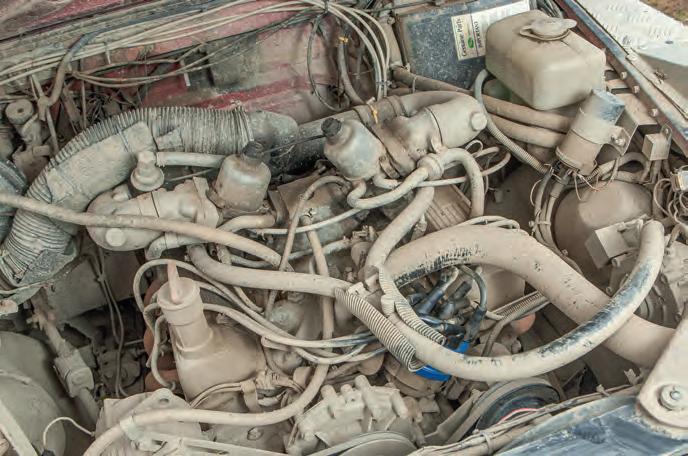
Above: There are plenty of V8-engined 90s around, but not many of them can claim to be a genuine Solihull original
Top right: Beneath all that mud is part of an LPG conversion. You don’t see many of these on off-road toys but it made a big difference in the 90’s days as a daily driver and it means passing environmentalists blow kisses and wave when Brian goes by
Above right: Captive engine mounts replaced the rubber originals after they fell victim to one shuddering blow too many
Right: The snorkel was chosen specifically because it runs within the line of the roll cage and is therefore well protected from tree hits. Its original top was replaced with what Brian calls a ‘chav air filter’; only problem is he found that with LPG, the ram air tends to cause misfires
An original V8, though? There’s something very special about that. Yes, even if the rest of the vehicle is barely recognisable from what left the showroom.
Which is the case with this one.
Dating from 1989, just before the Defender name was introduced, this here
is a bona fide Land Rover 90 V8 County Station Wagon. We found it in the hands of Brian Crabtree, who was responsible for it looking the way you see it here.
Well, sort of. See, it was the previous owner who started the ball rolling, and that’s quite an appropriate way to phrase
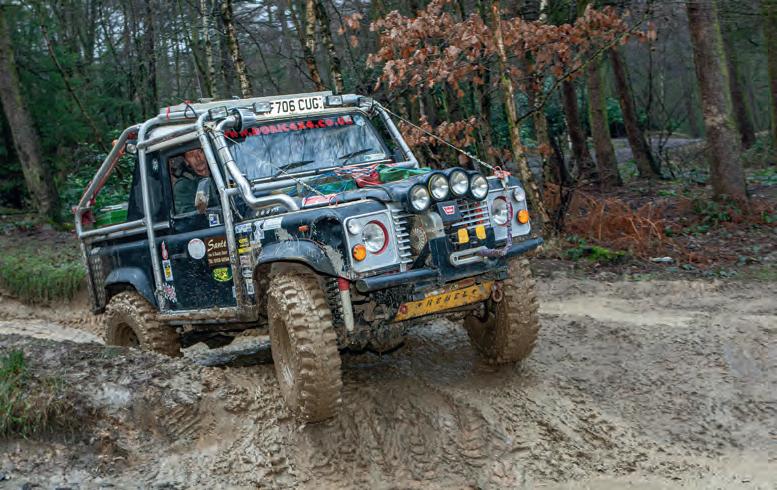


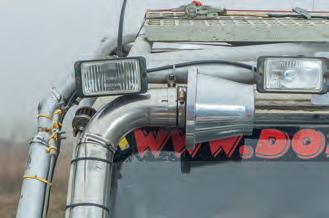
it because he or she also started the Land Rover rolling. We don’t know how it happened or whose fault it was, nor do we know how often it went over, but Brian bought it as a write-off.
His intention was to rebuild it and use it as an everyday car for the road. ‘But the roof was that badly bent it wouldn’t straighten,’ he says. ‘So I cut it down and made it into what it’s like now.’
Which is what? Well, the chassis is pretty much untouched, aside from the addition of mounting points for an additional set of rear shocks, and the gearbox is original (an LT77 or Santana, he’s not sure which, though he says it does whine a lot in third and that might point towards the latter). Over and above that, however…
Even the engine, despite being an original V8, isn’t unmolested. Brian converted it to LPG, so it runs with its timing well advanced, and it’s been tuned down to deliver better torque at a lower compression ratio. ‘The LPG is to keep it as green as possible,’ he says, ‘to keep the eco-friendly ramblers

happy…’ Not just because it’s cheaper, then? ‘That as well…’
Behind the gearbox is the transfer case from behind an R380, to which Brian bolted on an early-model X-Brake. ‘It was one of the first that X-Eng sold,’ he says. ‘Later ones had ribs on them, but ours is just a flat plate, and we’ve had to straighten it a few times – if you come down hard with it on a tree stump, it tends to modify it!
‘But it’s a fantastic piece of kit. You can go through all the slime and everything, and then you can hang the vehicle on the handbrake, no problem.’
Standard props, whose yokes have been opened out for more clearance at high angles, lead to 90 front and Discovery rear axles. The latter was added for its disc brakes, Brian’s condign verdict on the drums

with which 90s were still fitted in the preDefender era being: ‘They’re crap.’
Best not ask him what he thinks of Discovery halfshafts, then. ‘I’ve only ever snapped two,’ he says. ‘When I fitted the Disco axle, I ran it with the original halfshafts in, because I thought it was daft taking them out, and they only lasted a day!’
Not being one to mess around, he didn’t waste time putting in any calls to Genuine Parts. Instead… well, what do you think the odds might be of finding the word ‘Ashcroft’ in this sentence? The company’s shafts now take the strain in both axles, along with a set of Disco diffs with ARB lockers.
The front axle, as we said, is a 90 unit. The third 90 unit, in actual fact, that the vehicle has been through, thanks to heavy landings on boulders. At the business end is

Below left: Front axle is a 90 unit, albeit the third in the vehicle’s history. The previous two were bent into an early grave by heavy landings on rocks. A Rebel 4x4 steering guard protects a pair of Dan bars; Brian reckons all are unbeatable at the price, though the guard needed some trimming to keep it clear of the modified steering
Below centre: Ashcroft halfshafts in the front axle lead out into a set of 110 CV joints. With a V8 engine, 35” tyres, ultra-aggressive tread and a load of extra weight, the shock loads are going to be interesting to say the least
Right: Suspension uses a modest two-inch lift, with twin shocks and captive springs. Brian is no fan of dislocation, especially with front and rear ARBs minimising the need for vast amounts of travel
a pair of 110 CV joints, which Brian reckons are as good as the heavy-duty aftermarket alternative ‘if you use your head rather than your boot.’
Talking of boots, the drivetrain finally reaches terra firma (actually, it’s not always all that firma, but anyway) via a set of 35x10.50R16 Fedima Siroccos. Brian used to use a combination of Grizzly-Claws for off-roading and BFGoodrich Trac-Edges for the road, but the Portuguese remoulds absolutely converted him.
‘I’m not joking, they do take some beating. They’re two and a half years old, they’re used on and off-road, they’ve done several thousand miles and they’re wearing very well. As regards a road tyre, they really grip, even in what counts as high-speed cornering by Land Rover standards.


‘I take them down to 15psi for offroading, sometimes even lower, and beadlocks are a bit out of my price range at this moment in time, so I’ve knocked them off the rim a few times. I think that’s because they’ve a harder wall than a Simex, as they’re built on to a truck case.
‘But they do every bit as good a job –the only difference between them is that they’re remoulds. The only thing they’re not very good in is snow, as you’ve got to let the

pressures right down, but other than that they’re a fantastic tyre – I’ll never hear a bad word against them!’
Creating the space for the big tyres is a surprisingly modest two-inch suspension lift, which was one of the first mods Brian added after sorting out the 90’s crumpled roof. This uses Pro-Comp bushes all round; a standard A-frame ball joint is retained for

Left: Made from new CDS tube, the cage features a main front section with four pickup points on the 4x2 rock sliders and the compound rear brace you see here. Running down to the back bumper, this is removeable for easy access to the tub
Above: Where to stow your recovery gear? A cargo net on the bonnet means it’s always going to be handy, if not particularly dry…
Right: Fedima Siroccos replaced a set of Grizzlies and road-going Trac-Edges. Brian says he won’t hear a bad word about them
now, though a rose joint was in the pipeline when we spoke to Brian.
One thing you won’t be seeing on this 90, however, is dislocating suspension. Brian bent the standard rear radius arms by three degrees and reinforced them underneath with angle iron, but that’s as far as he’s taking it: ‘I can’t see the point. If you’re running a standard diff, or a Detroit or limited-slip, there’s a possibility. But if you’ve got your axle down that far, and it takes

up drive, it’ll just grip and it’ll wrap the arm underneath. I’ve seen it happen so often.’
Less controversial are his views on the pair of Dan bars he got from Protection and Performance to replace the 90’s standard drag link and track rod. ‘Nobody can beat the price,’ he says, simply, and the same goes for the Rebel 4x4 steering guard he picked up for a mere £45. ‘I did need to modify it to get the drop on the axle, as the steering arm was fouling it slightly, but as regards strength and hitting rocks and what not, I’ve not seen one to beat it.’
Something else he raves about is the Superwinch EP9 on the back of the vehicle. ‘It’s a fantastic piece of kit. It’s nowhere near as fast as the 8274 I’ve got on the front, but that thing has dragged vehicles everywhere. It’s unbelievable. It has an external cone brake which stops the drum from overheating, so its lowering capabilities are fantastic. The only drawback is that as you’re lowering, if you have to stop to re-rig or check your wheels, you’ve got to winch back in to release the brake before you start winching out again. That’s a good safety feature – though it can be a bit of a pain!’
Providing the power here is a 100-amp Range Rover alternator mated to two Optima Yellow-Tops. These are wired in parallel, which in Brian’s view obviates the need for split-charging, though another plan was to add a third winch and that would change things. ‘I’ll have to go for a primary battery, which will be an Optima Red-Top, for the engine, with the two Yellow-Tops for the ancillaries. Then I’ll probably have to put in a split-charge or a second alternator, with a standard 65-amp alternator to run the engine and the 100-amp for the ancillaries – if you’re using two winches at once, which does happen, you need that extra power.’
The winches sit on bumpers which Brian made himself using bits of metal rescued from other people’s scrap bins. The front one is in two-inch tube with a 4mm wall, combined with 4mm and 5mm plate and mounted on a U-section girder which is bolted to the chassis. ‘The thing you’ve got to watch when making a bumper is how far back you’re going to put it for your approach angle. Also, you get people cutting great big lumps of wing off; alright, you’ve got to cut a certain amount away, but you’ve got to remember that the bumper has to be a certain distance from your lights so it doesn’t deflect the beam. You end up
making it with one hand and having the MOT book in the other!’
Unlike the bumpers, the roll cage was made from new tubing, all of it seamless. It’s built in two pieces, allowing the back to be removed for access to the tub while the front remains in place.
This is the bit that does most of the work, as it’s here that four of the structure’s six pick-up points are found. All are on the rock sliders, which Brian made from 4x2 box; the back section braces this part of the cage by mounting to the rear bumper.
‘I got the MSA and RAC books,’ says Brian. ‘It basically looks the same, but they have different ideas. I looked at them and
took the best ideas from both. I was going to put a cross on the back, but I was told that as long as the driver’s side is supported, I had no need to put the other one on. I do still want to put a full cross inside, though. Then in my own mind I’ll feel a lot safer –though the idea is not to roll it, and if you do roll it to roll it as slow as possible!’
Chosen specifically to fit the cage, the stainless steel snorkel was a find at the sorely missed Donington show. ‘There was this chap, I don’t know his name, he had all sorts of stuff for sale. But he had one of these, too, and he also made ram air vents for your heater. It was just what I was looking for, because it runs inside the cage rather than outside or above it. I bought it then and there, not really knowing if it was
“I can’t see the point of dislocation. If you’re running a standard diff, or a Detroit or limited-slip, there’s a possibility. But if you’ve got your axle down that far, and it takes up drive, it’ll just grip and it’ll wrap the arm underneath. I’ve seen it happen so often”

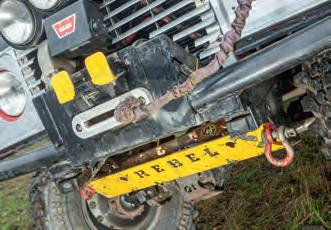

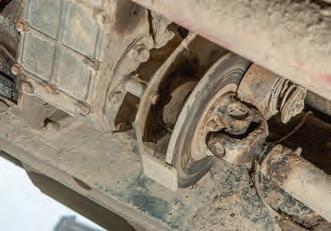
Above left: The home-made front bumper, fashioned from massively strong 4mm wall tube, sits on a U-section girder and supports a Warn 8274
Above centre: Rear Superwinch EP9 has spent its life dragging vehicles around like a tow rope but continues to impress Brian, who rates its lowering abilities as being among the very best on the market
Above right: Early X-Brake has needed straightening out a few times after being dumped on rocks, but continues to work perfectly
going to fit, but a few alterations here and there and it works perfectly.
Considering this is a challenge vehicle, and one which has taken more than its fair share of beating, Brian is remarkably canny about what he does and doesn’t do with it. Bog holes, for example, are more bother than they’re worth: ‘she can do it, but it silts up the radiator. Then it starts overheating, and you’ve ruined your day.’
Similar caution is behind the rev counter on the dash, which has a Max Power look to it but is there for a less exotic reason. ‘Sometimes when you’re wallowing in the crap and you’re giving it everything, you’ve got to be a bit careful. I do keep my eye on how far she’s revving.’
Brian even describes his decision to fit NAS style lamps as ‘a bit silly really, because I’ll just end up breaking them! I’m pretty good at backing into trees…’ A less complex choice was to stick with Defender seats: ‘You do slide about a bit, but at £200-plus each for a pair of buckets…’
As this demonstrates, while Brian’s 90 is a vehicle that would cost a fortune to build if you were paying someone else to do the work, it’s a classic example of how far you can go on your own driveway while still watching the pennies. After our photoshoot, he went home to the cross-bolted 4.6 V8 he had waiting to go in; at the time, he was debating whether to mate it to a Torqueflite box or the later four-speed ZF auto.
‘The position I’m in as a normal person,’ he says, ’is that whatever you decide to do, you’ve got to get it right first time, because you can’t afford to be making mistakes.
‘There’s things you don’t really need to buy, which are logical to make. I’m not trying to knock people who charge money for things, it just adds to the fun. I have more fun building vehicles… I have fun using them but there’s more fun building things, thinking about them, designing and testing them.
‘The idea is to overcome nature. Nature puts a challenge in front of you and the challenge is to beat it. Which is virtually impossible – but it’s good fun trying.’ Especially when you’re doing it on the V8 engine nature put there in the first place.
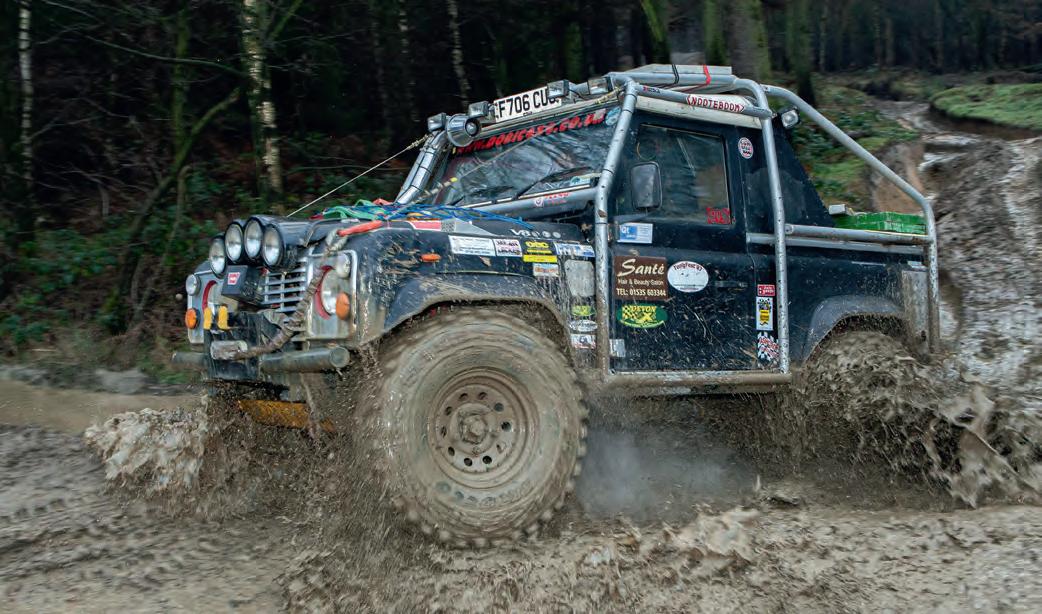


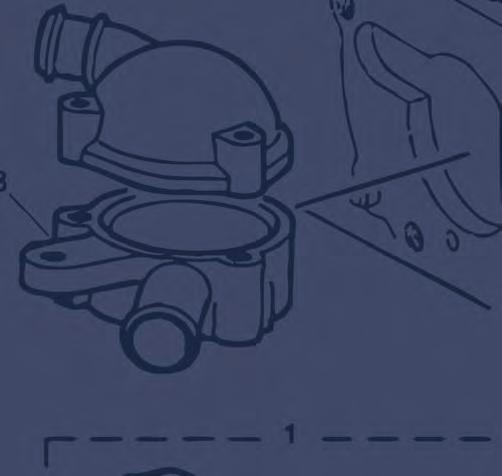


Own a piece of British motoring history with a classic British car! From the iconic Triumph to the beloved MGB, these legendary cars continue to capture hearts worldwide. Whether you’re restoring, maintaining, or upgrading your Triumph, MG, Rover, Mini, Morris Minor, Austin Healey, Land Rover, Range Rover or Jaguar we have the parts you need!
We guarantee the quality, we’re keen on price, we deliver fast and we know your car, ensuring your classic runs smoothly for years to come.
Join a passionate community of collectors and restorers who appreciate timeless British engineering. Explore our free catalogues today and keep your British car on the road where it belongs!
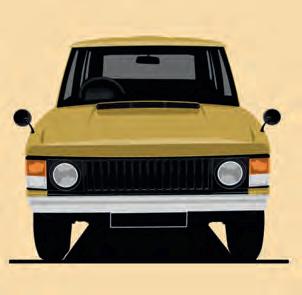

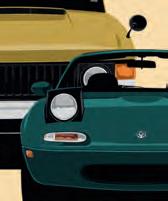


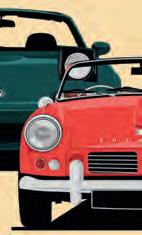
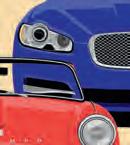





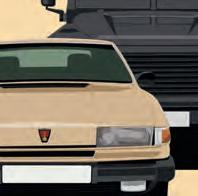




You could argue all day about whether this Series IIA is a classic Land Rover or a work of off-road butchery. Either way, it’s a brilliant bit of kit – and proof that for a good truck, evolution never stops
Words Gary Noskill Pictures Steve Taylor
When you’re into Land Rovers, it’s never hard to find a topic of conversation that provokes meaningful and highly passionate discussion. Diesel or V8? Manual or auto? Paint or patina? Old Defender or new?
I admit, that last one was like saying ‘Brexit: discuss.’ But if you really want to make a Land Rover devotee furrow his brow and suck air in between his teeth like a builder trying to figure out how much he can get away with quoting you, get him going

on the subject of butchering Series trucks. I mean, you’d have to be criminally insane to do that these days, right?
We’ll stress right now that the owner of the Series IIA in these pictures is neither insane nor criminally so. He did this with it a long time ago, at a point where Series Is had become classic but later leafers were still borderline disposable.
So it was still very relevant to ask: how far can a Series Land Rover be modified before it can no longer be regarded as worthy of the name? If you replace its leaf

springs with coils, fit it with Discovery axles and stick a different engine beneath its bonnet, is it still a Series Land Rover?
Well it won’t win the concours at many classic car shows, that’s for sure.
If there’s one dividing line between Series and hybrid, it would probably be the chassis. If this is original, or at least pattern, it’s still the truck it always was. If those coil springs are there because it’s on a Range Rover chassis, on the other hand, not an earthly.
Which brings us back to this one, which arrived at our photo shoot with Pather


Cannon behind the wheel. You can see that it’s non-standard, outside and in, with a home-made bumper up front, and beneath its bright yellow bonnet it’s been fitted with a number of later engines. Yet Pather went to considerable lengths to maintain its classic Series appearance. The radiator still sits within a recess, rather than flush with the headlights, it keeps its split windscreen and, most importantly, the axles still hold it up on leaf springs.
In terms of both appearance and significant elements of its specification,

then, this vehicle is every inch a classic Land Rover. And that’s just how Pather likes it.
‘I always intended to use it as a daily driver, he explains. ‘It made sense to make it a bit more comfortable, therefore – but I was keen to retain its distinctively Series character.’
When Pather took delivery of the vehicle, it was running with a soft-top and a 2.5-litre petrol engine had been installed by the previous owner. This is one of the strongest and most reliable Land Rover

engines ever produced, but it isn’t the most economical on fuel. Pather was happy to stick with it for a while, though, because there were other modifications that he regarded as more pressing.
First among these was the Superwinch X9 which continues to adorn the front end. And this posed the first home-brew challenge of the project.
The problem was that a standard Series front bumper, manufactured out of 3mm



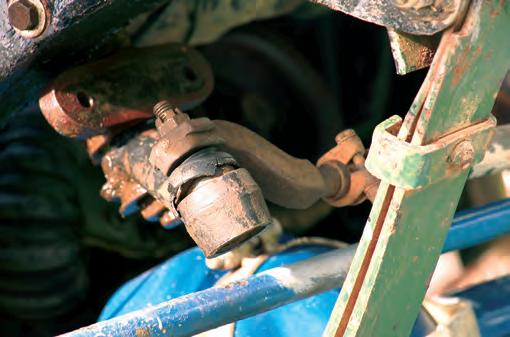
200Tdi engine is at the heart of the modifications; somehow, it fits in the engine bay behind the standard Series IIA front panel. Steering box is also from a 200Tdi, and is mated to a Range Rover column. Parabolic springs are grafted on to 90 axles, used only for their disc brakes
steel, was not made to house a winch. And Pather wasn’t keen to alter the truck’s appearance by installing one of the many off-the-shelf winch bumpers that were available at the time.
In the end, he decided the best course of action was to fabricate his own replacement bumper. This follows exactly the same design as the original and thereby maintains its standard appearance, but it’s made out of 7mm steel to give it a great deal more strength. The winch is mounted on a bracket provided by Superwinch, and Pather is very
pleased with the set-up, both in terms of how it performs and the way it looks.
There’s also a tow ball attached to the bumper, with a row of mounting holes allowing its height to be adjusted to suit whatever anchor point Pather has found for his snatch block. Safe to say no-one ever started a thread on a forum about how their Land Rover was going to be the best offroader the world had ever seen because it was going to have this, but once you’ve been out there and done it these are the things whose worth you come to appreciate.
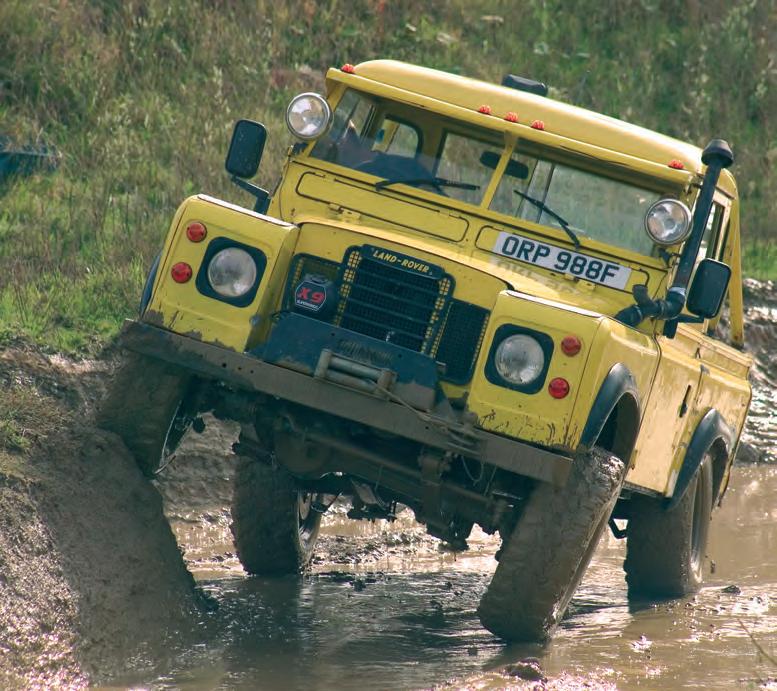
So too is an engine that does what you want of it. Pather’s old 2.5 petrol wasn’t, so he replaced it with a 2.5 diesel and that wasn’t either. ‘The diesel lump was certainly more frugal,’ he remarks, ‘but it was extremely slow.’
The extra effort of driving a vehicle that couldn’t scale a hill in anything higher than second gear began to take its toll. What Pather needed was an engine transplant that combined the economy of the diesel with the power of a petrol engine. You know what’s coming.
Sure enough, it wasn’t long before Pather was on the lookout for a Tdi engine from a Discovery. He opted for this over a Defender as the donor vehicle as they are much easier to find and, as a result, come with a considerably cheaper price tag.
The trade-off, however, is that the Disco’s engine is different to the Defender’s. In particular, the turbo sits a little higher in relation to the rest of the engine. Thus the turbo has to be repositioned if you want it to fit in the engine bay of a Series truck.
Scary? Well, Pather’s an HGV mechanic by trade. So, no. And better still, by sourcing a Discovery to break and selling the bits he didn’t need, he ended up with an engine that owed him for nothing more than his own spanner time.
‘I toyed with fitting a V8 for a while,’ he told us. ‘But I knew that it would be a silly thing to do in terms of my fuel bills.’ The Tdi engine offers a perfect compromise, as so many of us have found out. ‘It’s a pleasure to drive the car with a turbo-diesel engine fitted; and I think it’s probably more reliable than a V8 as well.’
The famously bomb-proof standard IIA gearbox, fitted with an overdrive, is bolted on to the engine, and Pather says he’s perfectly happy with it. The chassis, meanwhile, has been modified around the engine bay in order to make room for a 200Tdi PAS box and a Range Rover steering column. This makes the Land Rover much easier to manoeuvre on and off-road, and it also overcomes the wandering tendencies common to all pre-Rangey Solihull products.
Another modification Pather has performed is on the exhaust. When he bought the truck it was running with a stack in the rear load bay; he wasn’t satisfied with this set-up, which also got in the way of his plans to truck-cab the vehicle. In consequence, he redesigned the exhaust with a modified down pipe and a new tail pipe. Sorry, side-pipe…
Because of his admiration for traditional Series styling, Pather was keen to retain the standard radiator arrangement rather than follow the route of fitting a flush 90-style grille. The modern look had even more than usual to recommend it in Pather’s case, as the extra space on the newer Land Rovers is filled by the intercooler and radiator. It would certainly have made the transplant a lot easier to modify.
But no: it wasn’t happening. No way. Pather prides himself on the fact that his truck is still recognisably a Series Landy. ‘It was certainly fun to try and fit the engine in to the smaller space!’ he exclaims. ‘But I managed it and I’m pleased with the result.’
So he should be, and doubly so as the vehicle is still remarkably old-fashioned in many respects. As well as the gearbox, Pather has fitted a Series radiator and the servo is from a Series II. The battery, too, is a straightforward unit bought on the basis of price rather than specification.
The truck’s unusual combination of ancient and modern is never more evident than in its suspension configuration. Pather decided to install later 90 axles in order to get disc brakes all round. He did not go the whole way, however, because rather than mounting these with coil springs he opted for parabolics. Unless you’re a ridiculously attentive axle-spotter, therefore, you’d never tell at a glance that this vehicle is anything other than a very lightly modded Series IIA. If the parabolics are nonetheless a concession to modernity, Pather justifies
his decision to utilise them on the same grounds as his choice of engine. ‘If a vehicle isn’t exactly what you want, it seems acceptable to make it what you want. This car is my daily driver, so comfort is an important element.
‘The engine and suspension modifications improve this dramatically, and they don’t change the fact that it still looks like a Series Land Rover.’
In many ways, indeed, this vehicle features all that is great about classic Land Rovers while overcoming some of their obvious weaknesses. The parabolic springs are not only a great deal more comfortable than standard leaf springs for on-the-road use, but they also flex much better off-road and lead to a significant improvement in axle articulation.
So what’s next? Locking diffs, that’s what. You can certainly see these making it that much less likely that the IIA will either get stuck or break something in any given situation, so long as Pather drives with them in mind.
Factor in a set of 31” mud tyres on polished steel modular wheels and you have a cosmetically pleasing Land Rover that is also highly capable in the rough stuff. The snorkel that was fitted when we did our shots might not fit that description, but it was a temporary fix which Pather knocked up in haste when he wanted to have some fun in the water at a show. He was certainly planning to replace it with something that looked right, but it did the job and who
among us hasn’t doffed their cap to the odd farmer fix one time or another?
Other tweaks to the standard spec include aluminium door tops. These are fitted with military windows because Pather finds them easier to operate. Some have been observed to operate themselves on occasion…
The plastic spats on the wheelarches are standard aftermarket components designed for Series vehicles, and a soundproofing kit has also been fitted in the cabin to reduce noise levels. This is particularly important because Pather has stuck with the bare metal of the IIA dash rather than opting for a sound-absorbent plastic fascia.
Once again, however, this is all part of his desire to keep the vehicle as near to a standard Series Landy as possible. His philosophy has been that it’s fine to adjust the bits that benefit from being updated. But if there are aspects which function perfectly well in their original form, he’ll leave them unmolested for the sake of retaining the vehicle’s historic integrity.
Whether every Land Rover enthusiast would agree with Pather’s implied assessment of what constitutes a Series Land Rover is a matter for debate. But then, isn’t everything?
There’s one thing we can all agree on, at any rate. Whatever you think it is – a Series IIA, a hybrid, a bitsa or even a wannabee 90 – there’s no doubting the fact that it is an exceptional piece of kit.
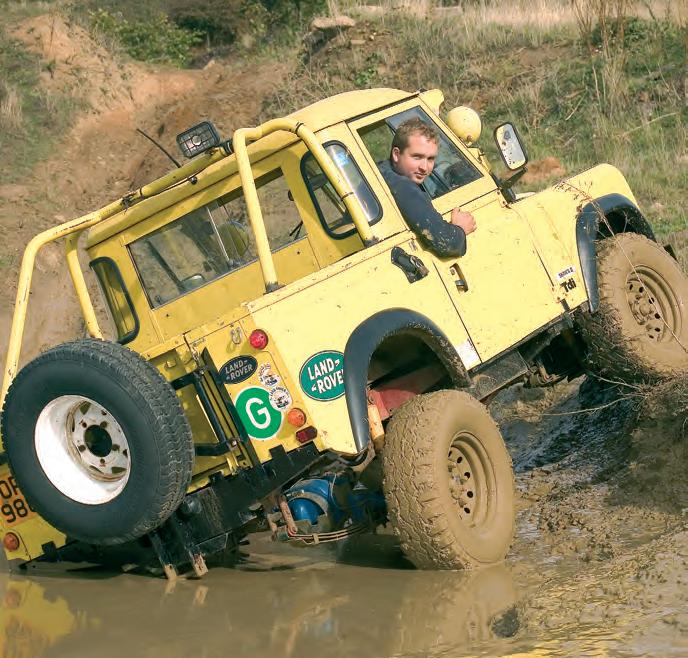

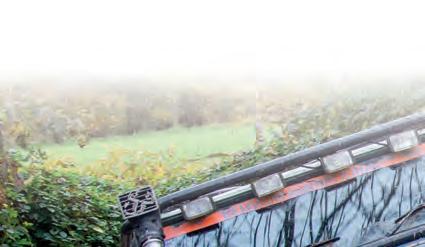




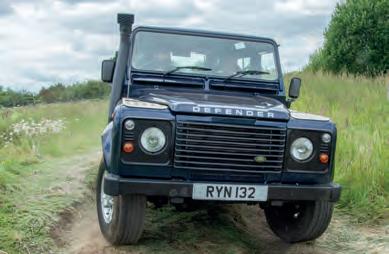












Land Rovers are returning to Stoneleigh this November for a day filled with Land Rovers!
Exhibitors old and new will join us, selling everything from parts & accessories to tyres, clothing and toys Talk to overland adventure specialists about your next trip, discuss modification options with companies with the know-how and other experienced Land Rover owners.



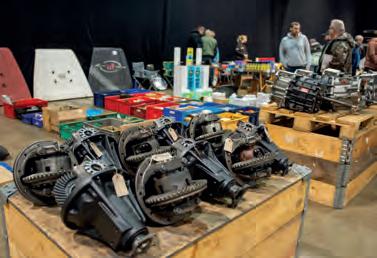
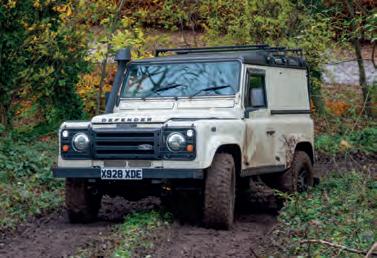

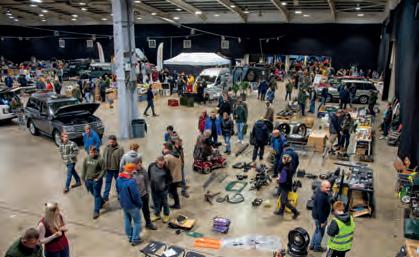

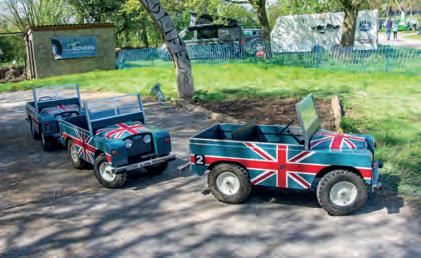





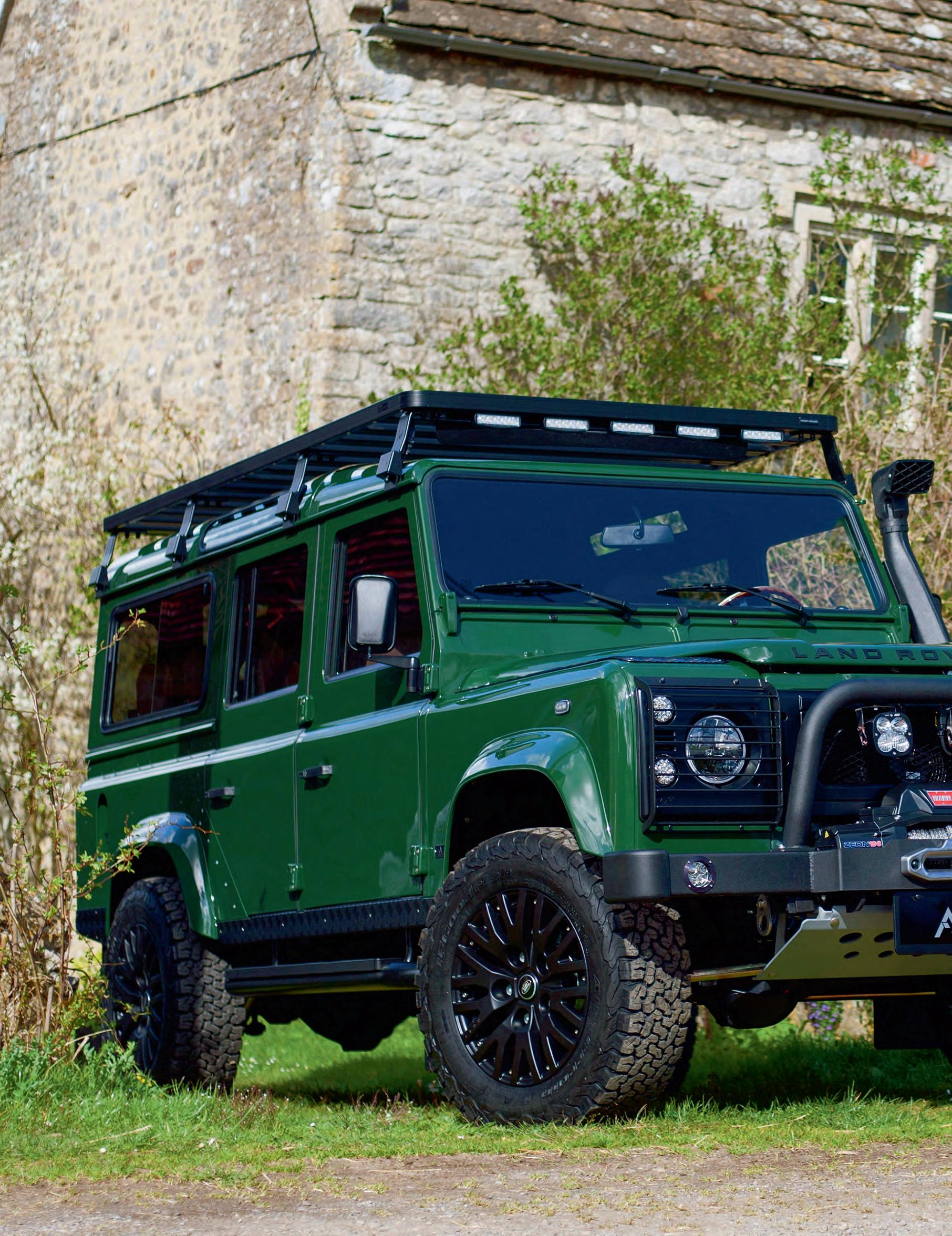




Just when you thought it was safe to go back on your television, the spectre of Games of Thrones continues to loom large in the shape of this battle hardened but still very elegant Defender 110
Words Dan Fenn Pictures Arkonik
In last month’s issue, we took a look at a stupendously cool early Land Rover 110 soft-top that had been remanufactured into the ultimate beach runner by the guys at Legacy Overland. It had just the right level of bling, just the right level of restraint, an engine to love (the original 2.5 petrol) and a beautiful coat of green paint.
Now here’s another 110 – and another coat of the same green paint. Coniston Green, which will be familiar to anyone who’s ever bought a Defender from new, but with a magnificent deep gloss finish that won’t.
Two similar 110s, then – but very different, too. This one’s a Station Wagon rather than a ragtop, and it’s left-hand drive – which is a bit ironic, because the American one was a right-hooked whereas this Land Rover is the work of Arkonik, the Somerset-based Defender restorer whose high-end refurbishments continue to find an eager market on the far side of the Atlantic.
Now, Somerset is not The North. But the 110’s name might put you in mind of all that. Dorne, Westeros, King’s Landing,
Winterfell, The North… all places we became familiar with during the eight-year reign (honestly, it really was only eight years) of Game of Thrones.
You might have put that era in a box now, so apologies for bringing it back out. It was an era of Candy Crush, Brexit and the irresistible rise of Taylor Swift. Apologies if you want to put all those back in their boxes, too. But hey, at least Oasis weren’t around.
Anyway, the point of all this is that Arkonik names the vehicles it builds. It built this one just as Game of Thrones was coming to its conclusion (cue debate on the meaning of the final scene, Jon Snow as Jesus and McMurphy led the twelve of us towards the ocean, etc etc etc) and since at that time it was basically the law that you had to speak endlessly about dragons, white walkers, direwolves and just how much sex it was possible for one set of humans to have with people they shouldn’t be, perhaps it was inevitable. So, ladies and gentlemen, we give you Drogo.
Khal Drogo was the fearsome Dothraki warlord and serial rodgerer of Daenerys Targaryen (you know, her, the woman who everybody was naming their daughters after


















until whoops, she turned out to be a powerhungry genocidal megalomaniac). They were happily married despite or possibly because of the serial rodgering, but then something a bit unclear happened (a witch may have been involved, possibly) and he was left catatonic so she bumped him off and next thing you know she’s emerged starkers from the funeral pyre, unharmed by the flames but now packing the trio
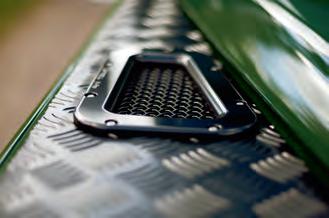
of dragons with which she goes on to conquer… well, wherever she fancies.
And there endeth the history lesson.
The real history (which involves a lot less in the way of naked women, I’m afraid to say) says that this 110 started off, as they so often do, in southern Europe. It was brought back to Arkonik’s base near Frome and turned into the top-notch expedition wagon you see here, complete with that

Coniston Green paintwork and a set of 18” alloy wheels.
Yes, 18”. There’s always someone who thinks Defenders only look right with more sidewall and less rim, but the Kahn Defend 1983 black alloys are certainly in keeping with the chequer plating along the 110’s lower body. The tyres wrapped around them are BFGoodrich All-Terrain KO2s, which says a great deal about the vehicle’s intent.
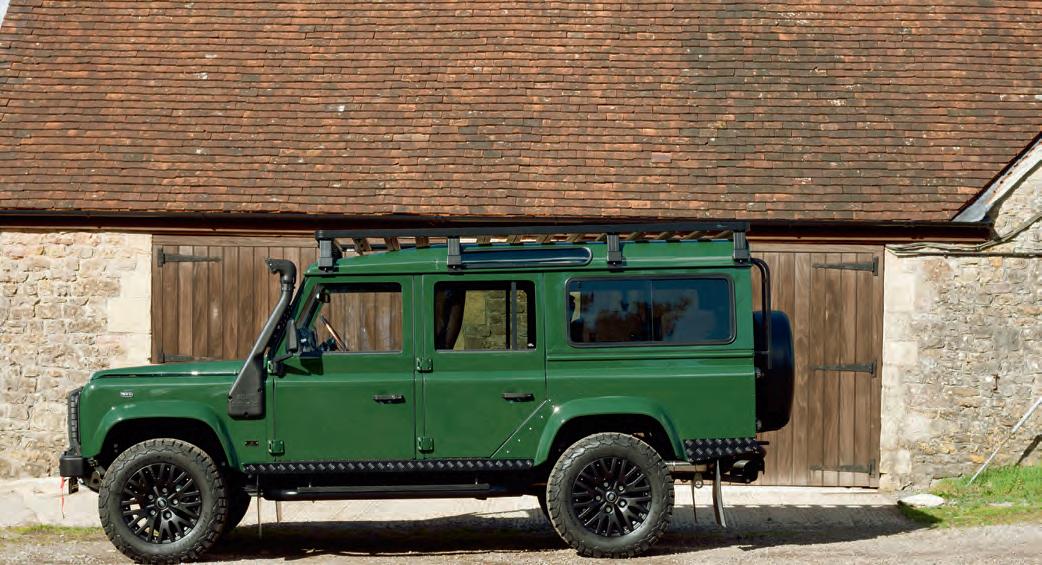

Underneath, the 110 rides on Terrafirma +2” suspension, and the same company is responsible for its uprated steering damper.
“The 110 is destined to ‘cross the sea to conquer the rocky mountain trails and canyon lands of western USA’”
Not that you can see it, because there’s a brushed alloy guard in the way.
Further good off-road equipment includes a Safari snorkel with full wading kit, Optimill wing-top air intakes, a NAS rear step with 2” square hitch receiver and a Warn Zeon 12-S winch. Arkonik’s own A-bar protects the front, where there’s a KBX Signature grille and steel headlight guards.
The headlights themselves are Trucklite Twin-Cat LEDs, and they’re by no means the only source of brightness on board the 110 Drogo. Baja Designs’ LED spotlights are mounted on the A-bar, there are five slimline driving lamps mounted to the roof rack and at the back there’s an LED work light. Also at the back, the tail lights are encased in plastic guards and a Front Runner ladder gives access to the aforementioned rack, the same company’s Slimline II.
Inside, the vehicle follows the normal rule – where there’s an Arkonik, there’s a spectacular cabin. And that’s never anything less than a very good thing. All nine seats, as well as the cubby lid and gear gaiters,
are trimmed in a beautifully muted Chestnut Brown leather – which, combined with black carpeting, a classic Evander 15” woodrimmed steering wheel and alloy gear knobs and door furniture, creates a wonderfully comfortable cabin ambience. There’s a sunroof, too, for when the weather is warm, and the front seats are heated for when it’s the other thing.
Finishing things off inside is a premium Pioneer multimedia system with a touch-
screen display. This runs Apple CarPlay, making iPhone pairing as easy as just plugging it in, and also operates as a reversing camera.
Arkonik, which builds its Land Rovers individually to customer order, says the Drogo 110 is destined to ‘cross the sea to conquer the rocky mountain trails and canyon lands of western USA.’ It should certainly last a lot longer than the Khal of Khals after whom it’s named, assuming of course it doesn’t end up being struck down by a witch’s curse. Though we doubt even that would be able to stop this Defender in its tracks…

Working on vehicles is a lot less fun when your fingers are blue, you can’t feel your toes and the breath is freezing in your lungs. That time of year is coming, of course – but spring was the perfect time for AL Services to carry out its first chassis replacement of the year, with a lovely looking ragtop 90 driving off on a new galvanised frame from Richards Chassis
Words Olly Sack Pictures AL Services

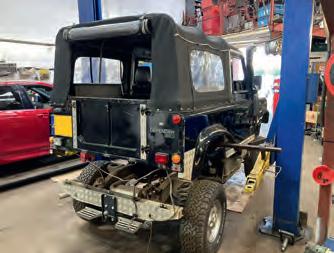
It’s a cool looking 90 but as we all know, those can hide all manner of horrors down below. In this case, the chassis had seen much better days and, with the vehicle’s long-term owner fully intending to stay that way, the time had come to stop welding and start lifting. We often say that Defenders are less like cars and more like houses in terms of the way their values work – you can refresh one and it’ll suddenly be worth a lot more money. Just as that doesn’t apply to simply redecorating your house, though, a coat of paint and a set of alloys will only fool the gullible. There are dealers we could name who trade on that, but a proper job starts where it matters. Rebuilt a Defender on a galvanised chassis and, while you might not get your money back if you sell it straight away, it’s long term value will be far higher
Afew years ago, we ran a story about a guy who had rebuilt his Vitara on his drive in the middle of winter. He described the days spent working away with the spanners for as long as he could stand then running into the house, warming his hands back up on a radiator and running back out for another session of suffering. It sounded, er, great.
If you’re doing it this way, of course, you really are at the mercy of the elements. But even a well equipped professional workshop is a hard thing to keep warm
So it struck a chord with us when the guys at AL Services, a leading Land Rover specialist in Poole, mentioned that their first chassis swap of the year was so much nicer to do in the gentle warmth of spring than the dead cold of winter. The recipient, a 300Tdi Defender 90 Soft-Top, has been in the same hands for many years and its owner has no intention of changing that anytime soon, so a new galvanised unit from Richards Chassis was the same excellent investment it always is.
For the uninitiated, upgrading to a galvanised chassis is more than just a way of keeping the MOT man off your back. You’re rebooting your old Landy from a position of total strength that will stay that way for years and decades to come –allowing yourself to relax in the knowledge that you’re not driving a bucket that’s going to break up in an accident. A chassis swap is not a full resto but it certainly is a new baseline for any vehicle.
Another benefit of doing this is that while the vehicle is apart, you can take the chance to renew or refresh it in areas that are normally impossible to get at. It’s rare for a chassis swaps to be just a chassis swap.
For a punter who already has a good truck, albeit just rusted out underneath, a professional rechassis job is the perfect solution – and if they plan it right, they’ll be driving away with what might as well be a brand new Defender. But a good many enthusiasts have rebuilt 90s and 110s on galv chassis with great success, too.
If you’re doing it on your drive, chances are it’ll be a long-term project and you’ll be renewing everything from the paint to the interior in the process. Do it right and this is a great way of getting yourself a comprehensively renewed Defender done to exactly the spec you want. Just be warned, though – if it’s a long-term project, that means it’ll span many seasons…

Here’s where you really don’t want to be doing this job in the depths of winter. With the body off, the chassis is rolled outside for a serious session with the jet wash – the whole of the drivetrain and axles is going to be going again, so it wants to be as clean as possible
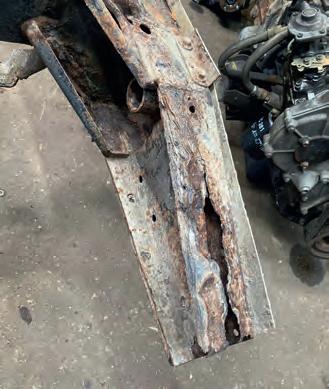
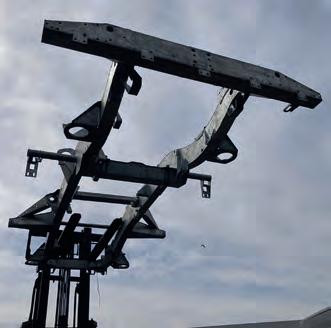
Plus, if you
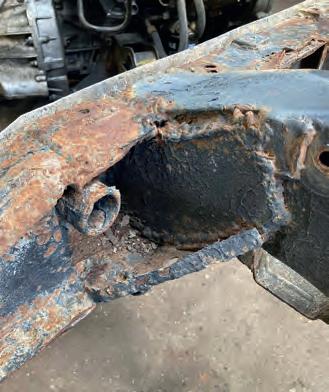
The old chassis had definitely seen much better days. The good thing about Richards’ galvanised chassis is that you’re not just replacing like for like – it’s a massive upgrade on the vehicle’s longevity
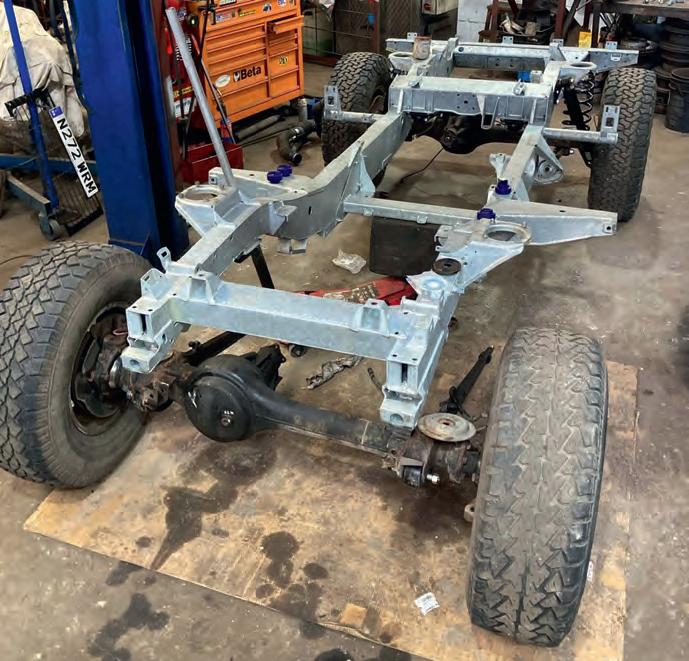
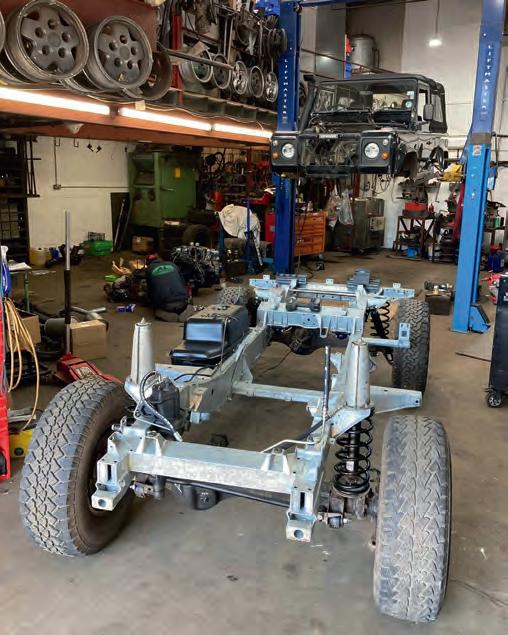

The engine and gearbox are back in place here, along with fuel and brake lines. It would be the falsest of economies not to instal a new clutch kit while they were out


Left: All the running gear went back on with a full set of Polybushes. Once again, long life is the watchword
Above: In the same vein, while the truck was apart its owner took away the fuel tank to be cleaned, treated and sprayed with stone chip protection

On goes the body, and we have a Defender once again. At this point, it’s the finishingoff jobs that are left – final connections, bleeding up the brakes and so on, then a lengthy test drive to show up any fixings that might have moved. There are jobs there which, however keen an amateur you might be, you still need to get checked by a pro before setting out aboard your freshly renewed chariot – but obviously when you’re paying an expert outfit like AL Services to do the job, once the key’s in your hand it’s job done










































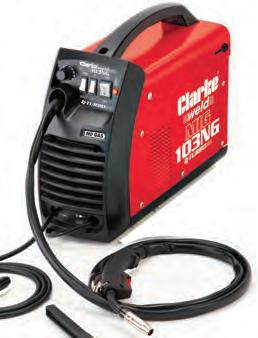






























































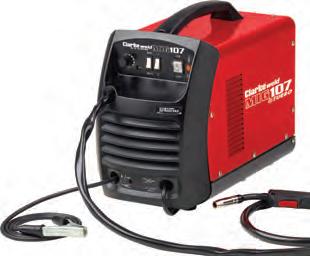





















































































































Green laning is a wonderfully slow-paced activity. But that doesn’t make you immune to a bit of a sugar rush when you’re out there doing it








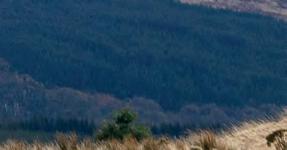



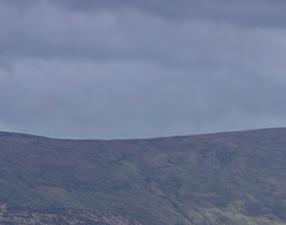









It’s grey. It’s dull. And it’s chucking it down with rain. I’m in Wales.



I don’t want to sound clichéd or anything. But each time I cross over the border into the land of the Red Dragon, it seems I emerge spitting out small fish like one of those moments from Tom and Jerry after one of them has drenched the other.
You can’t really knock this fantastic country, though. Because for 4x4 drivers, or indeed anyone who enjoys the countryside, it’s simply one great big expanse of wonderfulness. Got a fetish for greenery? Wales will leave you satisfied. And that includes green lanes.


‘I don’t suppose your name is John,’ I ask the man in the driver’s seat.
‘No. It’s Peter,’ replies the man.
‘Good start,’ I think to myself.

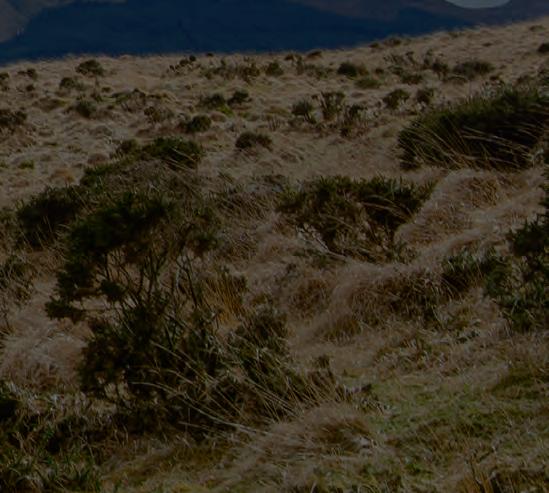
Everything here just feels somehow fresher than on the other side of the border. Could just be the manure filtering into the air, but more likely it’s the wide open spaces and green, green grass of… well, of Wales.
I’m making my way west, carving through Shropshire and running away from the urban sprawl of the Midlands. I’m aiming straight for Mile End Services on the A5, just outside Oswestry.
Yes, I’m aware that Oswestry isn’t actually situated in Wales, but it’s also got a Welsh name (Croesoswallt, since you asked) and that’s good enough for me. And judging by what falls on my head when I arrive and climb out it’s as good as Wales anyway. Besides, we’ll be heading over the border soon, so who cares? Best find our leader for the day.
I’ve been invited out for a day’s laning with the Muddy Millers 4x4 Club. And on the way into the services, I clock a pair of Discoverys. This seems like the best place to start my search. Two gentlemen sit quietly aboard one of them.

‘You’ll find John inside having his breakfast,’ reveals Peter. A-ha, so he is one of our group after all. That could have been embarrassing…
This will age the story somewhat, but there’s a Little Chef over there. A couple of text messages and calls later, John emerges from it. By now, a few other Land Rovers have joined us in the lay-by too.
John resembles what I imagine to be something like Ray Mears’ dad. A man that looks like he’d be at one with the animals – it’s a masked compliment, I promise, because he looks like the type of person who wouldn’t be at all flustered should he be faced with the prospect of sleeping rough in the Welsh countryside.
John’s grand-daughter Ella is with him. She’s seven, at least in this story, but if she’s reading it today it may be aboard a bus on the way to college, or work. If she’s not already driving herself.

Anyway, John announces that he wasn’t expecting me. He’s a bit of a comedian, in a good sense. Then he tells the group of our imminent departure and we suit-up for a day on the lanes.
We’ve barely travelled two minutes north up the A5 and I’ve already sussed that John is quite the character. ‘I don’t know why they follow me!’ he exclaims in his broad Welsh tone. ‘They must think I know where I’m going!
‘I set off from places and I always seem to have ten Land Rovers in my mirrors.




I say, “I’m sick of you following me! Get your own routes!”’ Ella seems used to her grandad’s sense of humour and sits in the back, quiet as a mouse.
Being invited on 4x4 clubs’ green lane runs is quite the privilege, not least because everyone I’ve met has been friendly, thoroughly approachable and just generally down to earth. People who just want to enjoy their vehicles and the countryside at once. It’s the same with the Muddy Millers, too.
April is just a few days away, but the showers have arrived already. ‘I’m enjoying the scenery a lot more these days,’ John tells me. ‘I used to find it all a bit too slow, but now if I’m out and at the back of the group, they’ll get on the CB and say “Where are you, John?” These days, if I want to go fast I’ll drive down the motorway!’
We’re heading through Chirk and soon taking the high lane above Llangollen Valley. John certainly wasn’t wrong about the scenery (albeit we only really get to enjoy the full vista when returning down this lane later in the day, by which time the heavy fog and rainy mist have finally relinquished their grasp).
It feels like we’re walking a narrow tightrope up in the heavens, with only a ridiculously steep descent waiting to claim


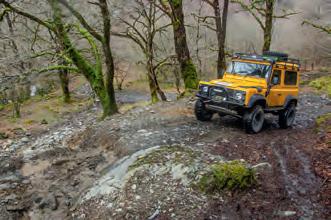
the soul of any living thing stupid enough to get on the wrong side of the boundary. Which reminds me…
I’m sure you’re all aware of what Red Bull is and you’ve probably noticed that they’ve stick their fingers into any pie revolving around sport. The marketing people there particularly like competitions for nutters – if there’s a video online of someone with a death wish getting a vast adrenaline rush, chances are there’s be a Red Bull banner in the background somewhere.
On the way along this lane, we passed the Red Bull downhill mountain bike course.
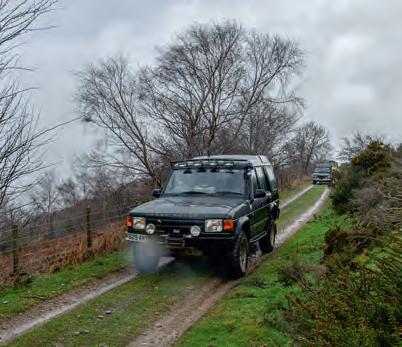

It has to be seen to be believed. Seriously, lunch? After looking at that? I’ll pass.
John and his Olympic Breakfast seemed to be coping with it all though. Must be the slow pace of life aboard his truck.
Speaking of food, as we make our way through Ceiriog Forest I’ve picked up on a rather ingenious strategy John has been using – with the help of his young assistant Ella, of course.
I’m sure you’re aware of the forfeit on rights of way, which is being the ‘gate attendant.’ You’re the guy at the back of the convoy, with the responsible job of making

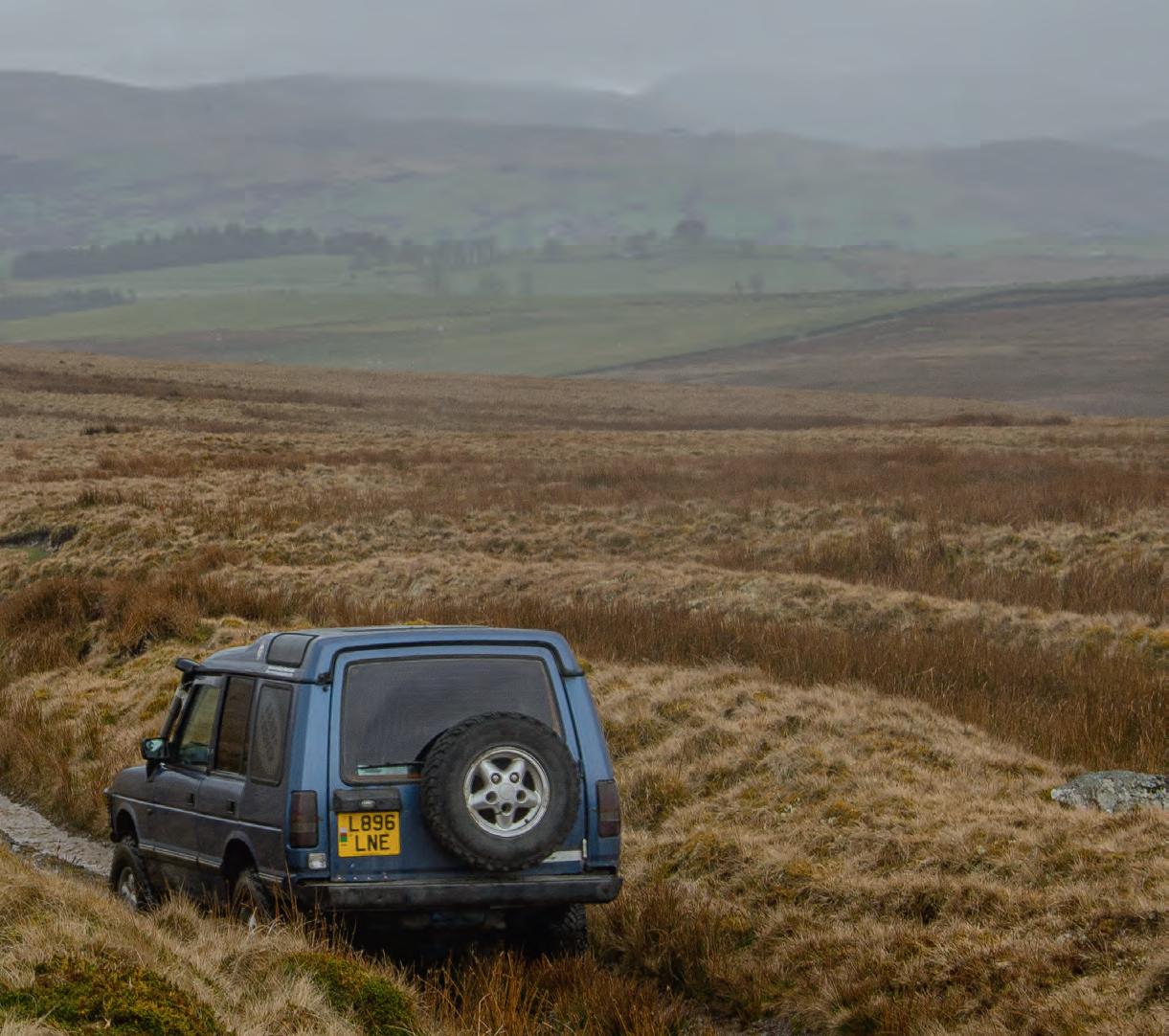

sure no-one gets left behind… but instead of honouring your sterling work as course closer, your mates mock you endlessly for being tail-end Charlie and having to get out every time there’s a gate to be shut.
Well, rather than let the back-markers get disheartened about having to do all the hard work after everyone else has swanned through, John ‘sweetens’ the deal for them. Here’s how it works. First, Ella picks out a lollipop from what appears to be a treasure chest of confectionary on the back seat. This is then handed to John before he gets out of his Discovery to open the gate for the following members. Once open, John places the sugary treat on the gate post for tail-end Charlie to pick up on his or her way through.
At the back of our pack, and presumably quite happy about it, are Lee Rogers and
his three children: Nathan, Harry and Amy. Naturally, the sight of a lollipop on the horizon would spur any child to depart from the vehicle post-haste.
After a couple of lollies each, however, it turns out there is only so much sugar a kid can take. These three are sensible in their consumption of tooth-destroying fuel, so happily we didn’t end up with any scenarios from Charlie and the Chocolate Factory. It’s never good when a lane trip turns sinister…
The Welsh weather is testing just how waterproof my coat claims to be and, now sitting with Lee and the kids, some familiar games soon spring up. ‘Guess the Animal’ soon throws out some spanners: I certainly don’t have any plans to meet this four-legged Anaconda I’m told exists. Kids and sugar can be a dangerous thing.
‘It’s something to do as a family,’ explains Lee, referring to the laning and not the

dreaming up of four-legged man-eaters.
‘I’ve been wanting to get back into it for a while, but it’s time and money. We try to get out on every laning trip we can; it’s a bit different to some of the other things you’ll do at the weekend.’
Back at the front, John tells me how he was very late getting into the whole laning game, having only been doing it for around four years and organising trips in just the last two or three.
‘I used to do a bit of shooting,’ he says. ‘Then I got a Land Rover and went out with Emyr (Emyr Rogers is piloting one of the many Discos on the run with us today) and his boss, who used to be the chairman of this club. We went out two or three times and I realised it would be cheaper to just join the club – so I did!’
From then on, John was hooked on laning. And in this area of the country, he’s lucky to have a multitude of rights of way on his doorstep. John told me (while laughing) that he tried walking in the countryside once, but that it was dangerous.
Lunchtime brings us to Llyn Alwen, where the weather resembles something a depressing montage of how bleak the environment can be. A road to nowhere, perhaps, though there’s plenty of wind to play havoc with those of us who try to water the vegetation.
We cross the A5 once more on our way into Gwydyr Forest Park, flowing past Ysbyty Ifan and rounding back towards Betws-yCoed. This is a small, thriving town and on a day like today (Sunday) it’s a haven for walkers, cyclists, horse riders and everyone who enjoys the great outdoors.
By mid-afternoon, the morning fog and drizzle has subsided and a potentially tense moment arises with one section of lane. A big rock lies stubbornly in the middle of a kink on a loosely gravelled track, and the only way round is to travel on the outside of the obstacle. No problem, really, but when John went first and dipped his back wheel off the edge for a brief moment, the look on his face was one of the best I’ve ever seen.
Wales is full of great lanes. Some force you to pull expressions you never knew your muscles could construct. Others will simply widen your eyes so far you feel it’s impossible to truly take in enough of the scenery.
A quirk with John’s truck is that he has to lift the lock on the passenger door before anyone can get in – as I find to my cost on numerous occasions. ‘I must get it fixed,’ he says. ‘Although it does keep out undesirables.’ Cheers.
We’re trundling through a section of wilderness that reminds me very much of the Isle of Arran, up in Scotland. Vast, open moorland with wild grass and heather rising up from the Earth’s surface, and with the Sun’s rays at last bursting through the grey blanket of sky, it feels like one of those moments where good triumphs over evil.
Some of these tracks are forestry routes. That means they’re wide and easily driven,
but they’re still a means of travel that enables you to see so much of the countryside in one day compared to if you were being propelled along by nothing other than your own breakfast. John’s a caring, sharing chap, though – and when we pass walkers, he’ll keep their spirits up by dishing out more of those lollipops.
On the way back, our convoy meets a car coming up a little country lane. With four vehicles behind us, we’re not the ones to do the reversing; sometimes you expect the odd harrumph from the other guy, especially when it’s so obvious that we’re out having fun, and that’s exactly what seems to be about to happen here.
Guess what happens instead? Yes, John stops before we pass the car in question,
winds down the window to a now baffledlooking group of individuals, passes on a selection of confectionary – and drives off, leaving the occupants with smiles as wide as the ones the lanes have given us.
It’s amazing what you’ll find just off the A5 – a road which stretches from the port of Holyhead, on Anglesey, deep into the heart of England, carrying on like a spear to the south of Luton to finish at Marble Arch.
John tells me that he tries to keep things as fresh as possible and never do the same lane twice. He’s lucky to have a road like the A5 nearby in one sense, but in another it just goes to show you that a small scratch beneath the surface can be all it takes to find hidden treasure. All you need is four-wheel drive. And lollipops.
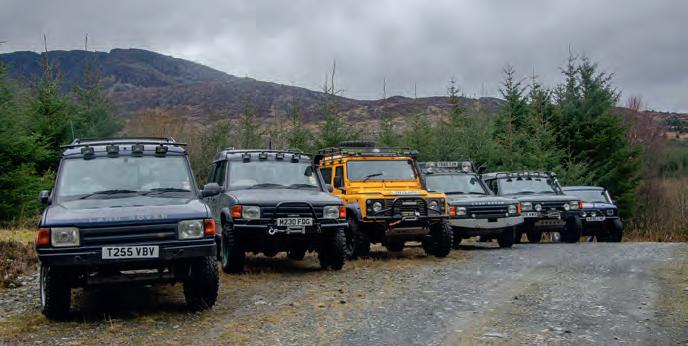
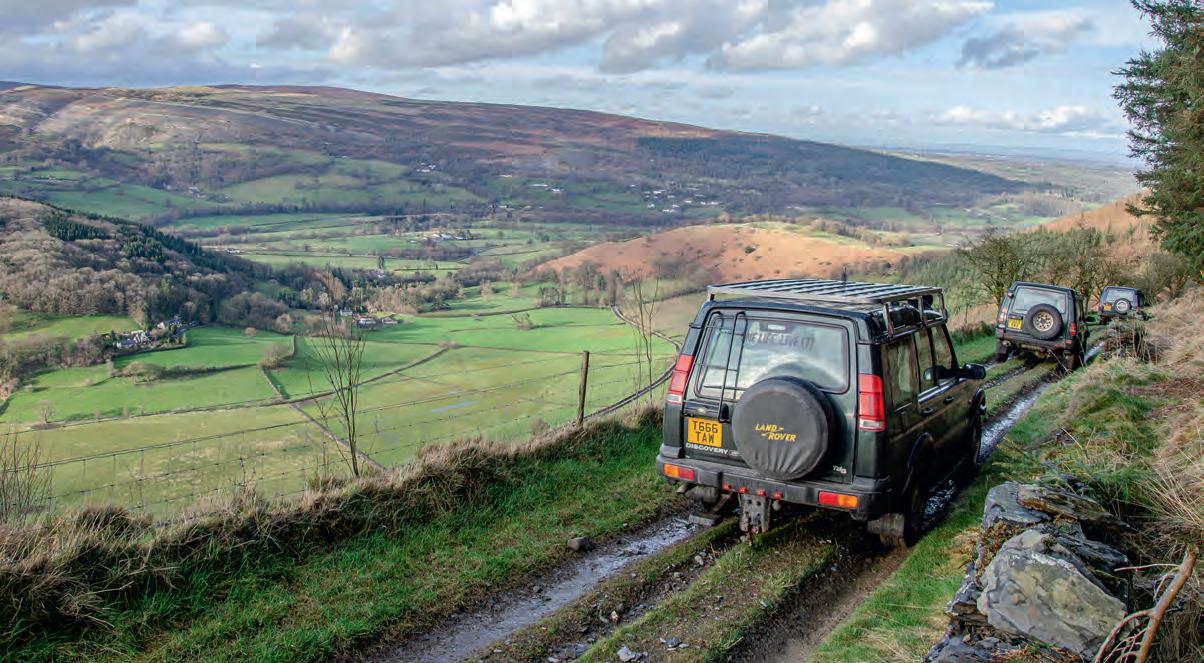









As the song says, three is the magic number. Except in the case of the Discovery 3, its trick is to make all your money disappear. Yet one couple used it as an overlander with such success that they came home having done three continents

























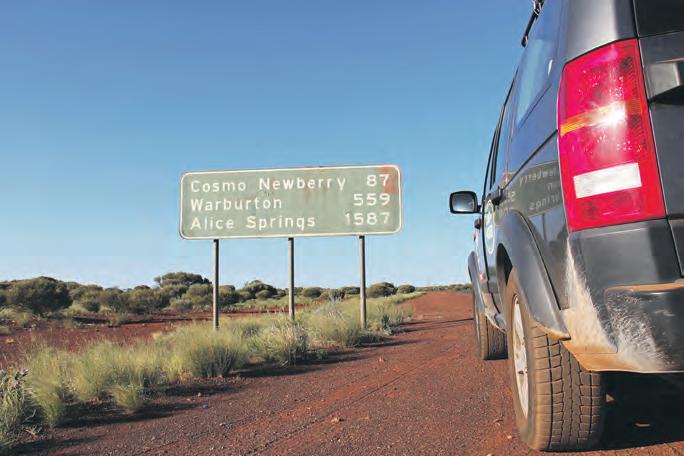






With most overlanding stories, you expect to hear people talk about how their battered Land Rover 110 never missed a beat because of its 300Tdi engine. Or if they weren’t quite so lucky, how they managed to fix it with some gaffer tape and a few whacks of a hammer.
That’s why overlanders will tell you that the simplest vehicles are the best. There’s less to go wrong in the first place – and if the worst should happen, the simpler the vehicle is the closer you’ll be to someone who can make it right.
So, choosing to go round the world in a Discovery 3 would seem to go against the overland code. For one thing, airconditioning and a CD player come as standard! For another, there’s a reason why the two words you’re most likely to hear from Disco 3 owners are ‘money’ and ‘pit’ – that reason being that they contain an awful lot of complicated stuff to go wrong.
But just because something seems to go against conventional wisdom, that doesn’t make it wrong.
Jen and Noam Ben Tsion are both very keen travellers. But to get that really true sense of freedom, they wanted to pack their home into their 4x4 and go where they wanted to go and not where bus tours, trek leaders and anyone else wanted them to go.
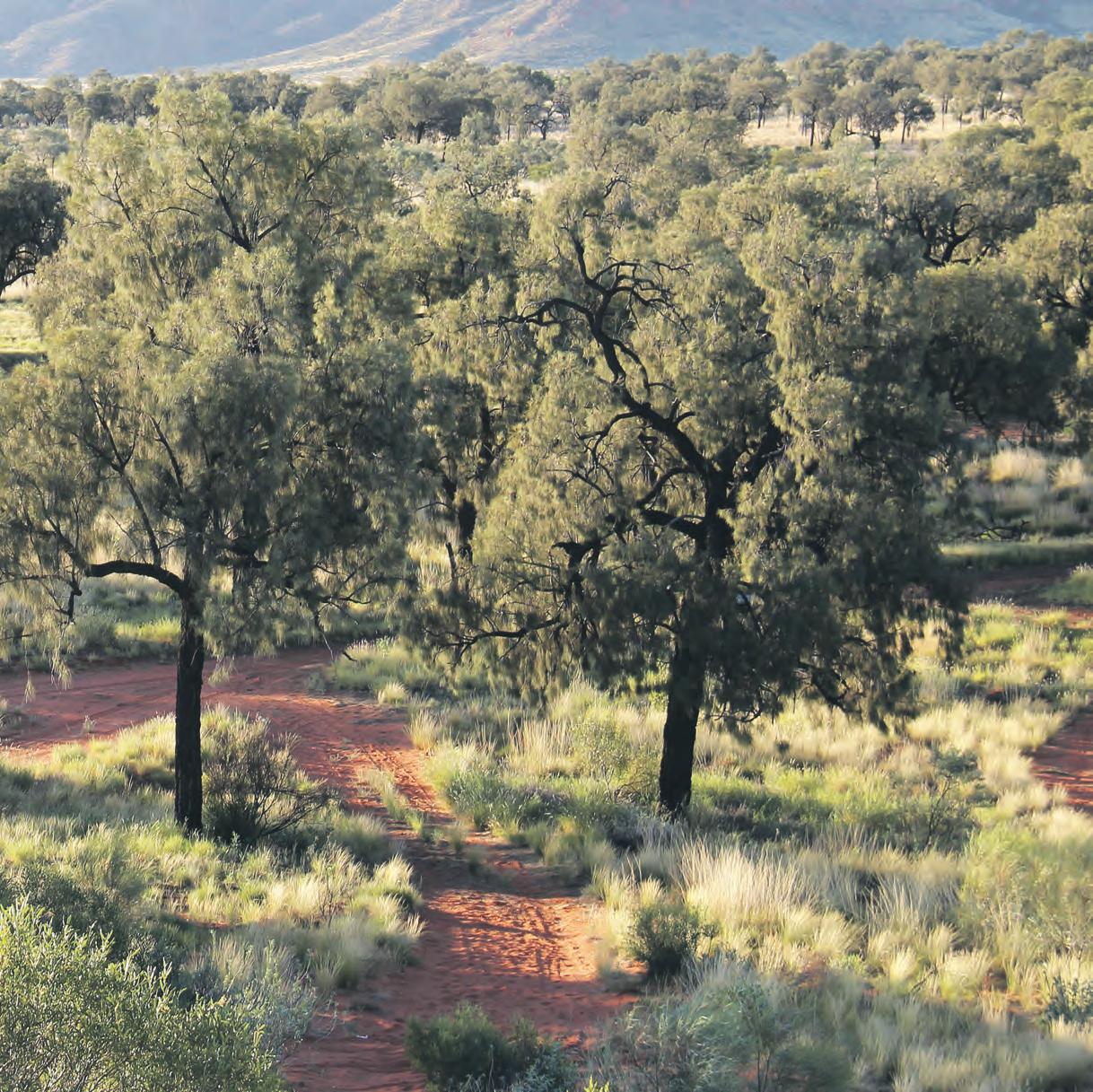

So they did. After quitting their jobs and leaving their cat with some instructions on how to use the tin opener, the excited couple left the UK back in April 2011 and began making tracks through Europe as

You don’t have to travel to the furthest flung corners of the world to drive your 4x4 amid landscapes that feel as if they come from a dream. To the right is no less popular a holiday destination than Turkey; above is Albania – even closer to home, if not quite as well known among the ‘taps aff’ brigade
they meandered eastwards. You could still do that back then.
Sometimes, it’s only after an experience has taken place that you can really look back and register what was truly going through your mind. Noam tells us he had a few issues worrying him before departing: ‘My main concerns were getting arrested, being locked up somewhere truly awful and, worse, not being able to find vegetarian food for Jen!’
Fortunately, they planned to go further than France, so vegetarianism was only a
brief problem. The pair also escaped the wrath of the Australian desert (just) and the wildernesses of Mongolia, Russia and many other places along the way.
Now, remember how you heard me say they did all this in a Discovery 3? You weren’t imagining it, they really did. It was a 2006 model, they named it Boudicca and together they explored three continents on their travels.
‘We wanted it to be a nice experience, so why not have the heated seats for Siberia and the air-con for Australia?’ says Jen. ‘We also wanted the added security of being able to sleep in the vehicle if
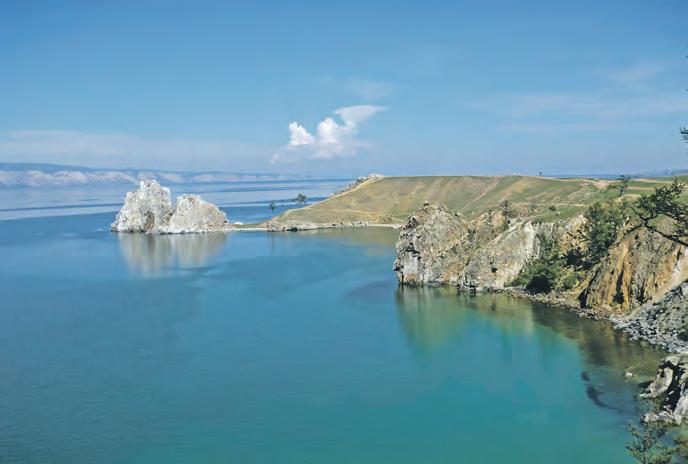
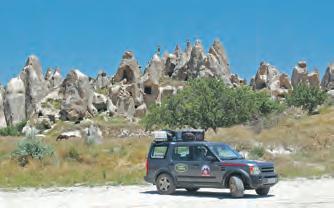
necessary, so the middle row of seats were removed and we created a sleeping platform – we got ourselves an Ikea mattress and fashioned some curtains with Velcro drawbacks. It was homely.’
The pair weren’t just able to fit a furniture showroom into their Discovery, either, with a small kitchen area and a bookshelf (presumably for the unlikely scenario of them being bored). Their own kitchen at home had become like a scene from an FBI thriller, with pins dotted all over a world map indicating their next area of investigation. It is, as Jen put it, like a game of dot-to-dot, trying to formulate some sort of route by connecting them up.
Speaking of routes, for Jen and Noam their time in Europe was as much about adventure as it was a test run for the more
Containing an estimated 20% of the world’s fresh water, Lake Baikal is bigger than all the Great Lakes combined. It was still possible for expedition travellers to explore the region when Jen and Noam took this trip, but as always geography comes a poor second to geopolitics





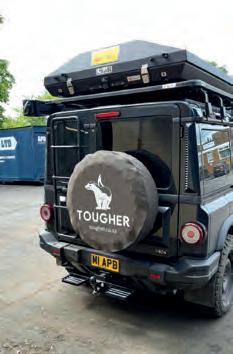








• Escape Gear
• ...and many more!


• Aluminium canopies
• Roof tents and roof racks



• Off-road fridges and 12v gear
• Drawer systems and slides




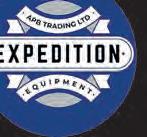





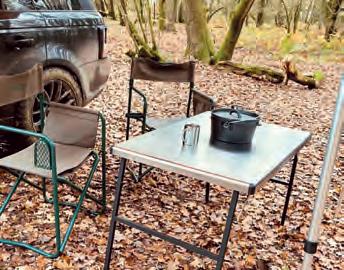




• Bumpers, side steps and vehicle protection
• Campsite essentials, tables and chairs



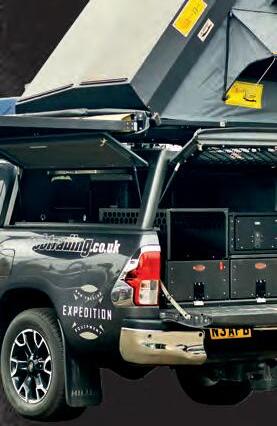
















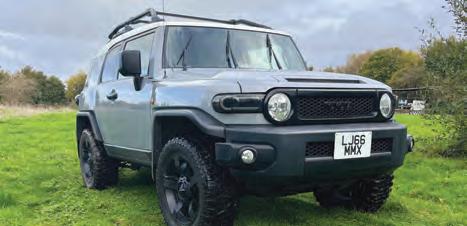
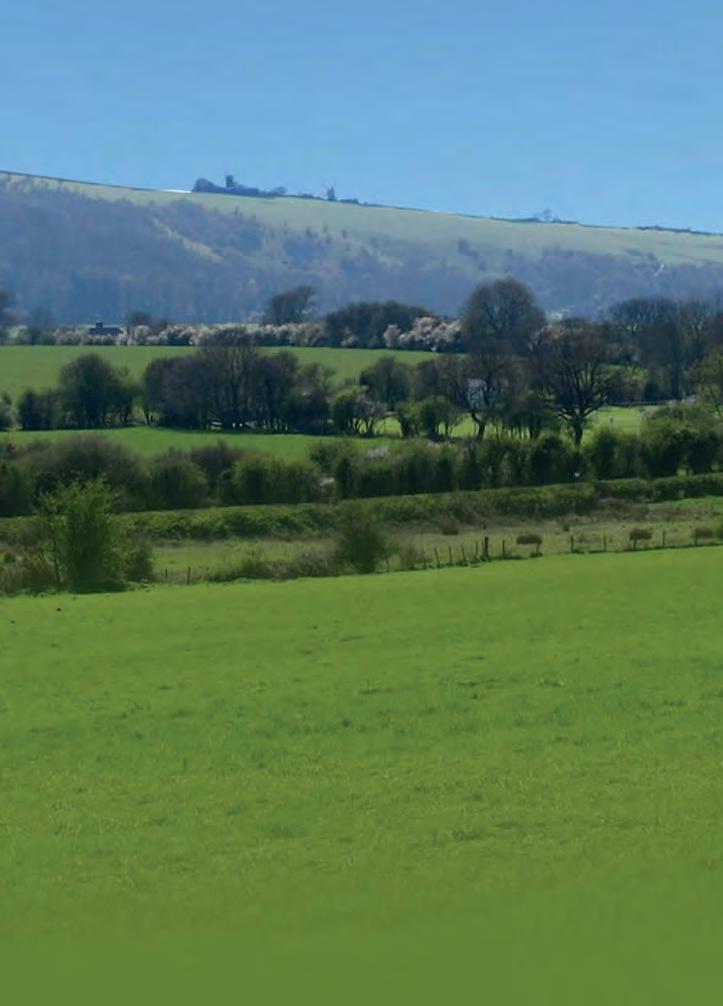


Cynghordy Llandovery Carmarthenshire, SA20 0NB Tel: 01550 750274 e-mail: info@cambrianway.com www.cambrianway.com

Family run guest house and self catering cottages with spectacular views, en-suite bedrooms, comfortable lounge bar and excellent home cooked food. Pressure washer, drying room, map room with local lanes marked, on-site 4x4 course, guides and GPS hire available.
A very popular venue for both individuals and groups of 4x4 enthusiasts

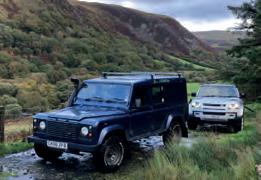
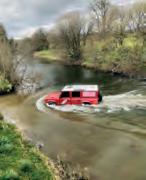









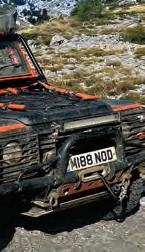

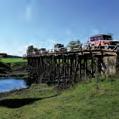


info@4x4adventuretours.co.uk www.4x4adventuretours.co.uk @4x4AdventureOverland 4x4adventuretours



Mention Kazakhstan to the typical Brit and the first thing they’ll think of is Borat. That’s unless they’ve ever travelled across the world’s ninth largest country by car, in which case the first thing they’ll think about is how featureless it was
extreme and remote locations they would encounter later on. Let’s run you through a rough itinerary: UK, Holland, Belgium, Luxembourg, France, Switzerland, Slovenia, Croatia, Bosnia-Herzegovina, Montenegro, Albania, Macedonia, Greece, Turkey, Russia and Kazakhstan.
You want more? They did. So onwards they went to Siberia and Mongolia before turning south through China and working their way through Laos, Cambodia and Thailand, then finishing off their voyage in the grand landscape of Australia. What you’re feeling right now, that’s called envy.
‘The time we spent in Europe did allow us to test all the gear out, making sure everything was going to be up for the rest of the trip,’ continues Jen. ‘Once you get east of Italy, going through the likes of Albania and Turkey, it changes very quickly.
‘We didn’t really encounter any problems. Boudicca was no trouble at all, really; we had the odd flat tyre, but not much else.’
It was Jen who did most of the driving along the way, and in the process she proved that you should never judge a book by its cover. Just ask the hapless salesman who sold them the Disco: having sat in the passenger’s seat as Jen gave their new home a thorough examination
A camp site to remember on the way from Tsetserleg to Bayankhongor (other spellings are available) in central Mongolia. This is at an elevation of somewhere between 2000 and 4000 metres above sea level. Camping is a way of life on Mongolia, and pitching up like this is no problem at all
both on and off-road, he was never the same again.
Neither was the German bloke who unwisely insulted the Land Rover and quickly came to regret it. You never diss a man’s wheels, and you never diss Jen’s home on wheels.
While the couple did mainly stick to existing routes on their travels, as we all know there are plenty of places in the world where that still means you’re offtarmac. Not that even that was enough to keep Jen happy. ‘Laos was particularly nice, and good for a bit of off-roading,’ she says. ‘There was lots of red mud to go and play in!’ Overlanding traditionalists, this is the bit where you shudder.
With so many different places visited, it would be hard to pick a favourite from among all these exotic lands. For Noam, though, the north of Mongolia was perfect for an outdoor enthusiast – and a person who enjoys a bit of extreme sport.
‘People in Siberia were lovely and always happy to help if you needed it,’ adds Jen. ‘We found Russia quite isolated at times, but then you’d come across a truly amazing oasis out of nowhere.’
At night, Jen and Noam were able to camp next to deserted lakesides, barren landscapes or at the foot of vast mountain ranges. That tailgate certainly came in useful anyway, not least for cooking on or, if the weather wasn’t matching the

backdrop, they could play a round of cards or plan the following legs of the journey.
Going back to the Discovery 3 once more, the truck may have been embarking on a goliath pilgrimage but there was nothing goliath about its modifications. In fact, there weren’t any. Boudicca managed the whole trip on standard road tyres and even helped out a couple of other Landies along the way.
‘We had to use the Terrain Response system and Hill Descent Control at
different points and the car coped very well. There was a 110 and a Patrol with us at one stage of the trip and our Boudicca did everything that they did,’ recalls Jen.
Whether it was the terrain they were taking on or the cultures they were taking in, Boudicca allowed Jen and Noam to bring home so many different memories. Even here in Europe, people can forget how varied cultures can be – even between
places as close together as the UK and France, never mind the likes of Albania and Montenegro. So on a proper long-haul journey like this, you really are going to experience places that are a world apart in every sense.
Here’s a snippet from their journey that you probably wouldn’t hear from someone visiting the UK, for example. Jen and Noam found themselves in Georgia, making their way through valleys and picturesque countryside. While searching for a route,

the couple were stopped – quite literally –for a tea party.
They’d stumbled across a small village called Kalicaya, a place they will now remember for its hospitality like no other. ‘Locals, mostly old men, were sitting outside around wooden tables, playing cards and sipping tea,’ says Noam. ‘We were passing slowly when one of them spotted us, walked into the road and signalled us to pull over. When we did, he started to fire orders to his friends and
immediately our table was ready with chairs, tea, sugar and cookies.’
Every overlander has stories like these. And everyone who has never been an overlander doesn’t. Reasons to be an overlander, part 47b…
It’s a world away from our 24-hour environment of smartphones and the latest Instagram post from your mate showing you what he’s having for breakfast that morning. A lot of this region is under the radar to everyday tourists, simply because
so many other European countries get all the headlines. Which of course makes it all the better to discover in your Land Rover. China was a rather different experience. Here, Jen and Noam were met at the border and seen through fairly promptly by the official ‘guide’ they were required to employ. You’re never really alone in China. That’s not to say they didn’t get to sample the cuisine or admire some of the country’s unique architecture, though. There are often surprises with trips like these, some

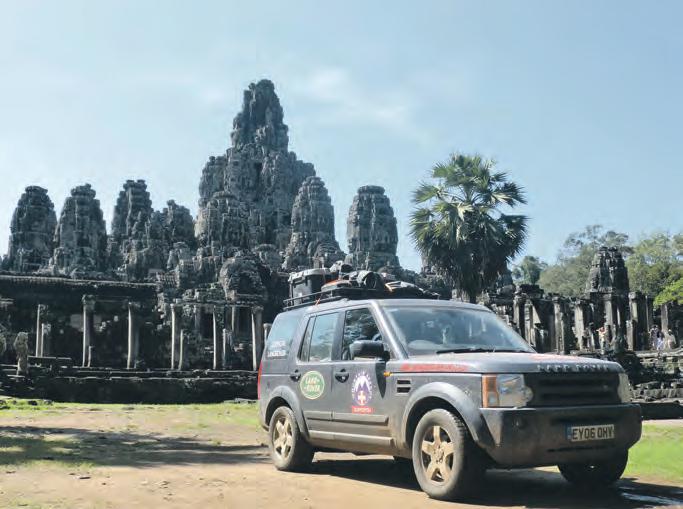
good and some bad, but hopefully the latter is outweighed by the former.
Tuva, for example, has a bad reputation. Before Jen and Noam went there, they were warned that they could be knifed by drunken locals or perhaps on a different day they’d be stoned instead. It’s one of the most southerly regions of Siberia and is considered particularly dangerous.
‘This place is famous for throat singing; they’re really big on their music,’ says Jen. ‘People in Kyzyl, the capital, warned us to stay in compounds for safety. We met a nomad, though, who invited us to his family camp, and there we spent some time learning about their culture, riding their horses and eating their foods. Ignore the warnings – to not go would be missing out. It is simply beautiful.’
As Jen and Noam migrated from place to place, they kept tickets and postcards along the way, pinning them up on the ceiling of their Discovery so that at night they could look back at the different locales they’d been.
‘I think if we went again, we’d try to factor in the Stans too,’ says Jen. ’Places like Afghanistan and Pakistan; I wish we could have done those, but they’re not the easiest to get visas for.’
Crossing the odd border can be a bit of a jaunt, but crossing the ‘best before’ date on your tomatoes can represent a different challenge. Jen and Noam’s Ikea on wheels may have had most things, but it didn’t have a fridge. No, overland experts of the world, not even that. ‘Next time, we’ll take one with us and I’d recommend it. Stuff just keeps that bit longer between
stocking up.’ What would have happened if the Disco’s air-con had broken down is anybody’s guess, though.
There was another problem towards the end of the trip, which provided Jen and Noam with the sort of memory you look back on and shudder. Picture this: you’re travelling along one of the Aussie Outback’s many endless dusty tracks, this one in the Northern Territory, when all of a sudden your Land Rover decides to shed one of its four wheels on to the ‘highway’. This then rolls off into the distance in a bid for freedom.
‘It was a clenching moment for sure,’ remembers Jen. They had to fix up Boudicca after grinding to a halt in the red road, which meant handing over more than just a few dollars. Unfortunately, the parts had to be shipped over, so while the Disco was being prepared once more for the open road, the couple carried on towards their next port of call. Jen and Noam managed to fit in Victoria and Tasmania too, but that’s as far as their most recent chapter goes.
The former Khmer capital of Angkor, which flourished between the 9th and 15th Centuries, covers some 400 square kilometres. Good luck getting to park this close to a Unesco World Heritage site in any country that’s not Cambodia…
‘A lot of people seem to be playing with the mini retirement concept at the moment,’ Jen explained to us. ‘I think we will plan to do something like that, maybe in five or six years’ time; while you’re still young and able to, you may as well make the most of it.
‘We’d like to do the Pan-American Highway at some point, I think that will be next. When you’re out there you really do feel free. Obviously you have to think about some things, like where you’re going to get your next load of water from, or diesel!’
If you had travelled thousands of miles, seeing more of the world than you could ever imagine, you’d like to think retirement will be a more relaxing and safer experience. After Jen and Noam finished their voyage of 2011, Boudicca was passed on to Gary, their mechanic, for exactly that.
‘He knows where she’s been and has given her a good home,’ says Jen. But they’re looking to the future now – and while Boudicca won’t be returning to the Outback, they’ll certainly be returning to the open road one day.
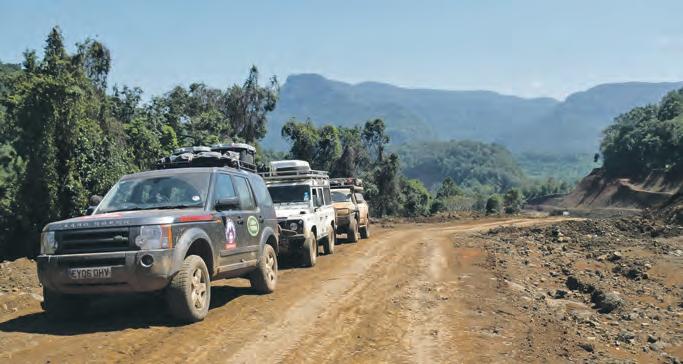
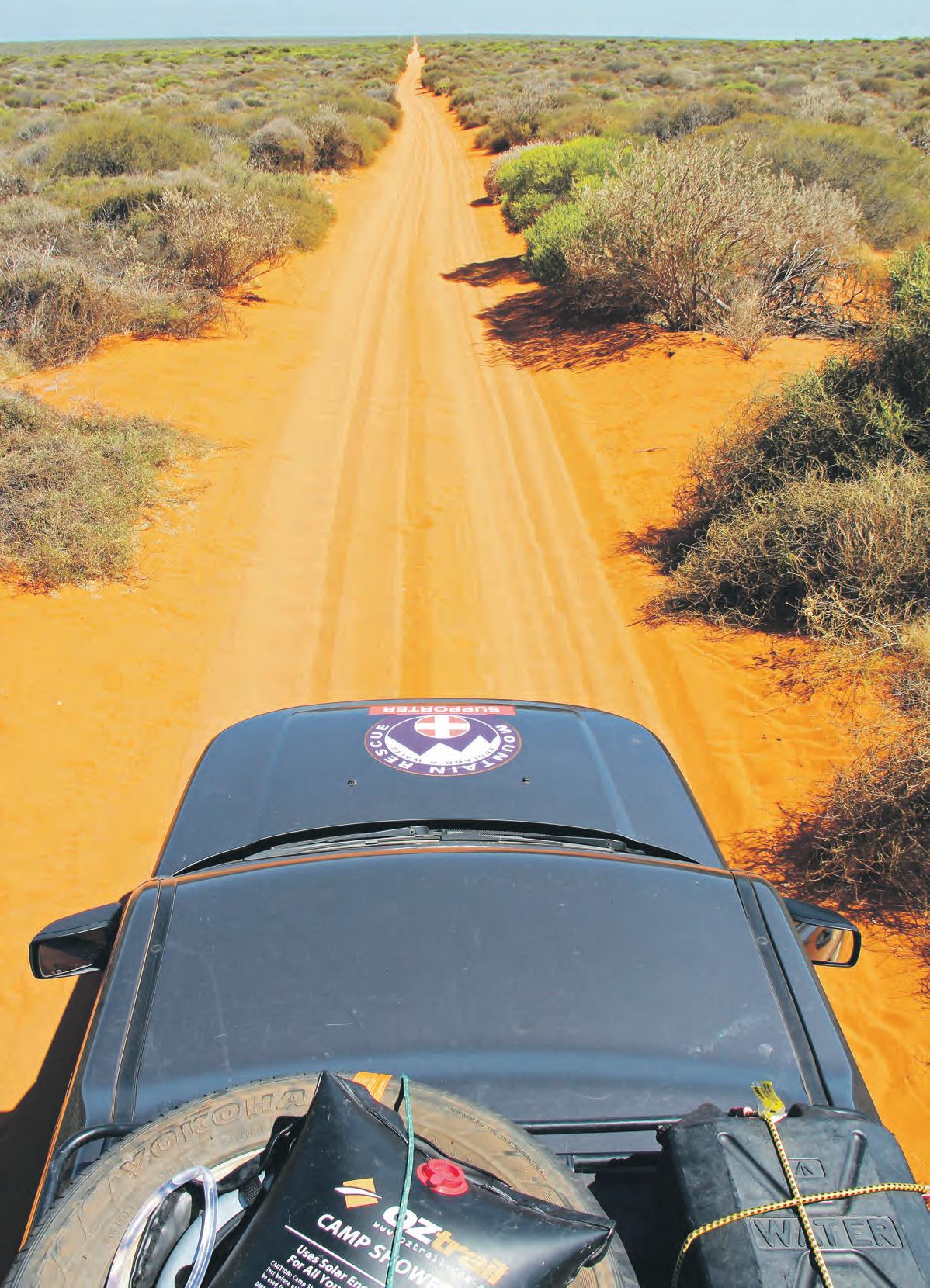

Jen and Noam covered thousands of miles in three continents during their overlanding adventure. Such an experience is bound to give you plenty of memories – too many for one article. As a result, Noam has written a book about their journey called Overlanding: A Drive to the Other Side of the World. It’s available on Kindle, with all proceeds are being donated to Mountain Rescue, England and Wales. If you’re into travelling, this is well worth a read.









Dyed-in-the-wool Volkswagen enthusiasts proving there’s more than one way to modify an Amarok




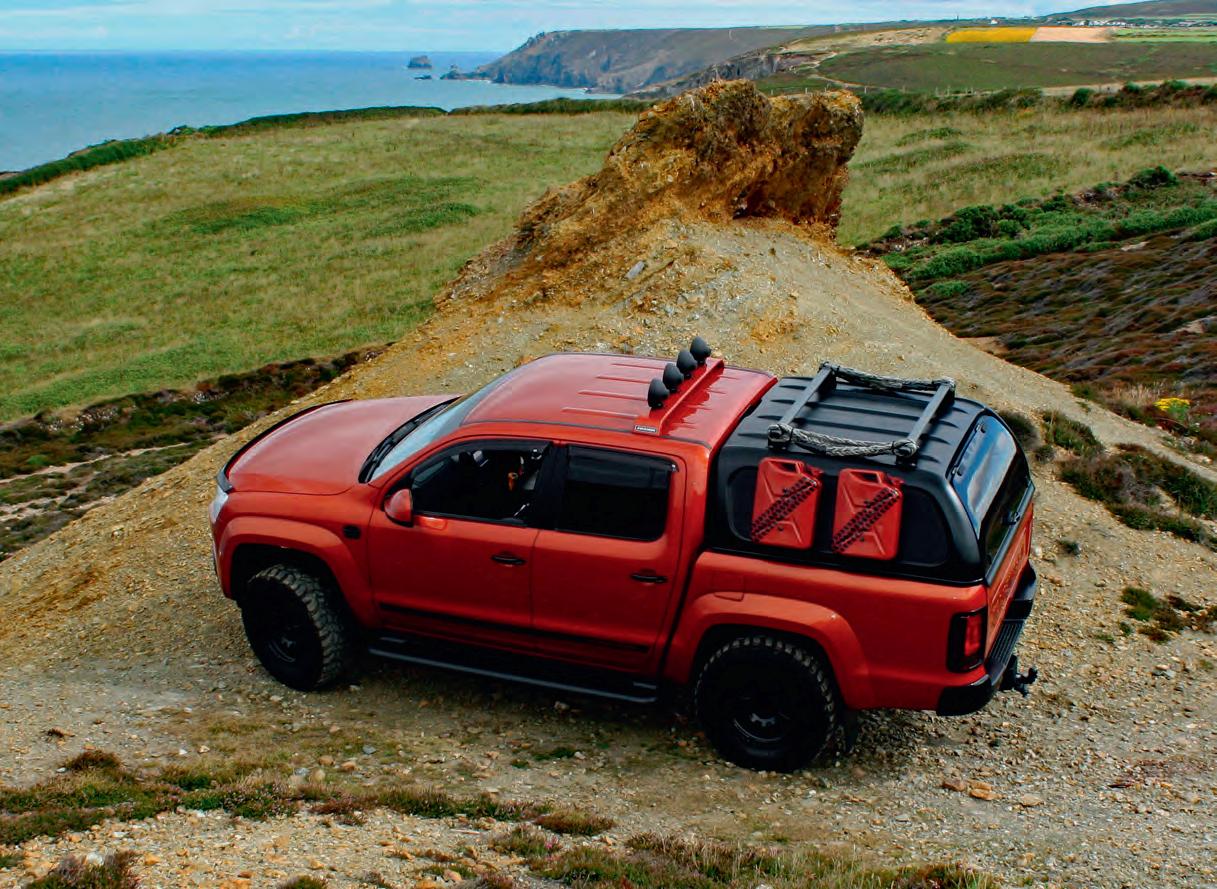
Radical off-road build for an early Disco
Unscheduled green laning in the new KGM Actyon
Exploring Namibia aboard a proper Land Cruiser
DECEMBER 2025 ISSUE: ON SALE 23 OCTOBER



































